Published on 5 October 2023 online
Acknowledgements
Project Management Team
Alan McHaffie - Senior Woodland and Recreation Officer, Belfast City Council
Maria McAleer - Performance and Improvement Officer, Belfast City Council
Kenton Rogers - Project Lead, Treeconomics
Ian McDermott - Technical Lead, Treeconomics
Danielle Hill - Senior Urban Forestry Consultant, Treeconomics
Prepared this Tree Strategy in collaboration with the project managers, the stakeholder group and the individual consultees and experts.
This project was part funded by the Woodland Trust.
Workshop Participants
Dr Mark Johnston MBE - Advisor
Ian McDermott - Advisor
Joe Higginson - Woodland & Recreation Officer, Belfast City Council
Declan Hasson - Planning Officer (trees/landscape), Belfast City Council
Orla Maguire - Biodiversity Officer, Belfast City Council
Anthony Conway - Parks Manager, Belfast City Council
James Noakes - City Innovation Broker, Belfast City Council
Richard McLernon - Project Co-ordinator, Belfast City Council
Malachy Campbell - Senior Policy Officer, NI Environment Link
Malachy Brennan - Regional Grounds Maintenance Manager, Belfast Region, NI Housing Executive
William Hancock-Evans - Senior Lecturer in Global Change Ecology, Queen's University
Trevor McClay - Network Maintenance Manager, Department for Infrastructure Roads
Bill Fulton - Senior Civil Engineer, Department for Infrastructure Roads
Roy Armstrong - Operations Manager, George Best Belfast City Airport
Simon Rees - Regeneration Project Officer, Belfast City Council
Gregor Fulton - Estate and Outreach Manager, Woodland Trust
Nina Schonberg - Nature Recovery Networks Project Manager, Wildlife Trust
Craig Somerville - Partner in Belfast One Million Trees, National Trust
Jim Bradley - Manager, Belfast Hills Partnership
Lisa Critchely - Belfast Hills Partnership
Emma Sharpe - City Regeneration Project Officer, Belfast City Council
Mura Quigley - Adaptation and Resilience Officer Climate Team, Belfast City Council
Mark Whittaker - Senior Planning Officer, Belfast City Council
Project Manager
Senior Reporting Officer - Stephen Leonard, Neighbourhood Services Manager, Belfast City Council
Authors
Kenton Rogers - Treeconomics
Danielle Hill - Treeconomics
Catherine Vaughan-Johncey - Treeconomics
Harry Munt - Treeconomics
Ian Mc Dermott
And for Section 2 - Introduction and Background
Dr Ben Simon - Advisor
Dr Mark Johnston MBE - Advisor
Foreword
Belfast City Council produced this Tree Strategy to help it manage and improve its tree-scape so that it can provide a resilient and diverse urban forest for future generations. The Belfast Tree Strategy lays out a clear vision which focuses on protecting, enhancing and expanding its woodlands, hedges, and trees, connecting people to nature, and ensuring that these continue to be a major asset to everyone who lives in, works in, and visits our city.
We are seeing changes in our weather patterns as a direct result of climate change and trees can help adapt our living environment and mitigate some of the effects of climate change.
The Belfast Tree Strategy reflects the aims of key city partners, including Belfast City Council. 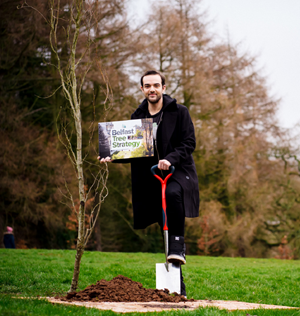
It draws on existing programmes such as Belfast One Million Trees, the Belfast Local Development Plan (LDP), and the Belfast Agenda. It also connects with the Belfast Resilience Strategy, Green and Blue Infrastructure Plan and will deliver 37 key actions over the next 10 years with a review of the strategy once every three years.
We know through our consultation that there is significant support for the development of this strategy and through this strategy and its delivery we are sending out a clear message, that our city’s trees are valued and need to be protected and cared for over the coming decades.
I am delighted with the commitment and vision council has set out in this strategy and encourage you to read it.
Cllr Micky Murray, Chair of People and Communities Committee
Contents
Acknowledgements
Contents
Section 1
Introduction and Background
1.1 History
1.2 Current State of the Urban Forest
Section 2
Vision
Section 3
Action Plan: Targets, Priorities and Actions
3.1 Trees and Urban Forest Structure
3.2 Community Framework
3.3 Sustainable Resource Management Approach
Approach
Section 4
Consultee Feedback
Section 5
6.1 to 6.6 Technical Appendices
Technical Appendix I: Council Owned Trees
Technical Appendix II: Management Standards for Council Owned Trees
Technical Appendix III: Privately Owned Trees
Technical Appendix IV: Plantations, Shelterbelts & Woodlands
Technical Appendix V: Hazards and Safety
Technical Appendix VI: Policies Adopted by this Strategy
6.7 Bibliography
6.8 Glossary
List of Tables
Table 1: Urban Forest Estimates For Belfast
Table 2: Urban Tree Cover Estimates For Belfast
Table 3: Comparable Cities’ Canopy Cover Estimates And Goals
Table 4: Hazard Zone Categories - Occupancy
Table 5: Hazard Zone Categories - Hazard Level
List of Figures
Figure 1: The 3-30-300 Rule
Figure 2: Belfast Tree Strategy and its relationship to other policies, strategies and initiatives of Belfast City Council
Figure 3: Belfast’s Existing Canopy Cover By Ward
Figure 4: Richards “Ideal” Distribution Of Tree Age Across The Urban Forest Showing Typical Diameter at Breast Height For Each Age Class
Figure 5: Dominance Diversity Curves For UK Cities
Figure 6: Tool To Show Species Suitability And Carbon Sequestration Projections
Figure 7: The Street Lined Trees Of Belfast
Figure 8: Priority Habitats Across Belfast
Figure 9: Heat Map Of PM2.5 Concentration Across Belfast
Figure 10: Example Of Tree Stewardship Map - New York
Figure 11: Map Showing The Hydrology Of Belfast
Figure 12: Map Showing Belfast’s Queen’s University Campus And Surrounding Green Space
Figure 13: Tree Canopy Cover Across Belfast From Sentinel Data
Figure 14: Indices Of Multiple Deprivation Ranking By Ward
Figure 15: Trees And Design Action Group Species Selection Criteria Guide
Figure 16: Belfast’s Interactive Online TPO Map
Figure 17: Map Of Nature Reserves, SSSIs and Other Public Areas
Figure 18: Tree Pest And Disease Introduction In The UK
Figure 19: Uses Of Urban Wood
Figure 20: Ancient Trees Around Belfast
Figure 21: Torbay’s Open Access Webmap
Section 1 - Introduction and Background
“It is that range of biodiversity that we must care for - the whole thing - rather than just one or two stars.”
David Attenborough
“Some of my local streets have trees, some do not. I think all the streets should have them. During hot spells they provided much needed shade and improve the environment markedly.”
Belfast Resident and consultation respondent
1.1 History
The earliest descriptions of the landscape around the northern Lagan Valley date from the late 16th century. A map from this period by Francis Jobson is of particular interest as it distinguished areas with tall growing trees from areas of scrub. Jobson indicated that the lands southeast of Lough Neagh and in mid-Down had tall woodland trees. The districts around Carrickfergus, North Down and the Ards Peninsular were largely devoid of woodland and the Lagan Valley contained predominantly underwood.
With the development of the town of Belfast in the 17th century, much of the woodland in the northern Lagan Valley was cleared for agriculture, cut for firewood or used in industries such as ship building, tanning and charcoal-making for ironworks. However, some leases instructed tenants to retain trees and plant hedges and saplings, and surviving records for the Donegall estate from the 1730s and 1740s refer to the employment of men termed ‘wood rangers’, who looked after trees and hedges. A large woodland was retained at Cromac (lower Ormeau) until the 1790s, when the last trees described as principally oak with some ash and alder were felled. Also, recent tree ring dating at Belvoir Park has demonstrated that some of the imposing oaks that today grace this site have grown undisturbed since the mid - 17th century.
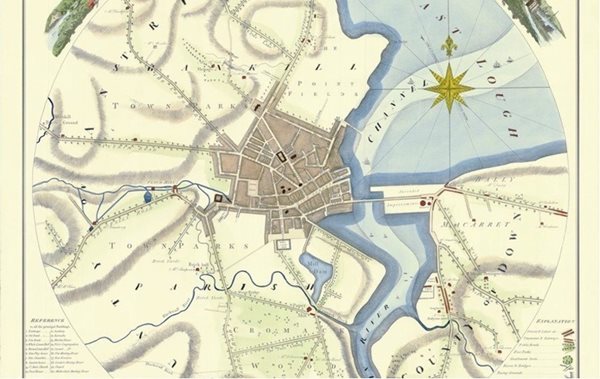
In the second half of the 18th century large scale tree planting started, supplied by local nurseries that advertised the sale of a wide variety of species including non-native trees and fruit bushes. Planting continued during the Victorian era in gardens, estate lands, on hill slopes such as Cave Hill, Colin Glen and Cregagh Glen.
Following the formation of the Belfast Botanic and Horticultural Society in 1827 a 14-acre site was purchased at the junction of the Malone and Stranmillis Roads for the Belfast Botanical Garden which opened in 1828. Its diverse collection of trees and shrubs from around the world were primarily for the enjoyment of the Botanic Society’s members until it became a public park in 1895 when the Belfast Corporation bought the gardens. Belfast's first public park (Ormeau Park) in the south of the city, opened in 1871 on land adjacent to the River Lagan, that was formerly part of the Donegall family estate. It already had many fine mature trees and these were supplemented by much new planting. In the late 19th and early 20th century, several new and extensive public parks were opened by Belfast Corporation, many of which also had plenty of fine mature trees. Following the Belfast Burial Ground Act (1866) the Corporation opened the Belfast City Cemetery near the Falls Road in 1869. This was followed by a number of other public and private cemeteries that added greatly to the city’s open space and tree cover.
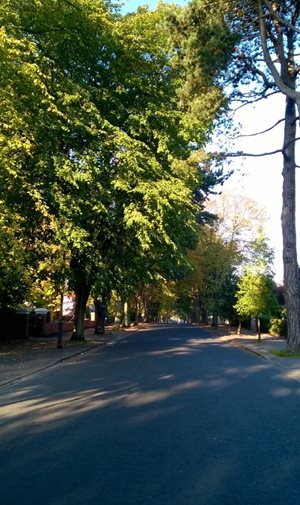 In 1900, the Corporation formed its Cemeteries and Public Parks Committee from what had previously been two separate committees. This was the forerunner of Belfast City Council’s City and Neighbourhood Services Department that now manages some 49 public parks, 9 cemeteries, and the vast numbers of trees and shrubs within them.
In 1900, the Corporation formed its Cemeteries and Public Parks Committee from what had previously been two separate committees. This was the forerunner of Belfast City Council’s City and Neighbourhood Services Department that now manages some 49 public parks, 9 cemeteries, and the vast numbers of trees and shrubs within them.
In 1846, Belfast Corporation established the Improvements Committee, part of whose duty was to initiate street tree planting. Unfortunately, there is little recorded evidence of this earliest planting. In 1900, street tree planting was taken over by the newly-formed Cemetery and Public Parks Committee. Most of these early street tree plantings were undertaken before and immediately after the First World War and comprised a limited range of species such as limes and London planes. By the late 1960s, pollution in the city had reduced to a level where a greater variety of species could be planted, such as hornbeam, cherry, birch, and rowan. From the late 1980s, systematic street tree planting in Belfast increased significantly with many more roads being planted, particularly in the suburbs. A considerable amount of this planting was initiated by the Belfast Development Office and by 1993 there were over 9000 street trees recorded on Belfast City Council’s tree inventory.
Throughout the 20th century, Belfast’s suburbs expanded steadily and many of the new residential properties, particularly in the wealthier districts, had quite large gardens. With the increasing popularity of gardening as a pastime, many were planted with some trees and shrubs, which then contributed substantially to the overall tree cover in the city. In contrast, much of the 20th century was marked by decades of neglect of woodlands and the felling of trees when the grounds of former big houses and private estates were sold.
In the period following the Second World War both statutory and voluntary organisations started to promote trees and woodlands and to advocate the protection of trees. The first big tree campaign in Northern Ireland was launched by the National Trust in 1945 to save woodland at Colin Glen in west Belfast. Tree Week was initiated in Northern Ireland in 1967 and has since been adopted throughout the UK as the main annual celebration of trees. The protection of trees through Tree Preservation Orders was introduced into Northern Ireland legislation in 1973.
By the 1970s it was widely acknowledged that because of a lack of planting and management, most woodlands had an uneven age structure, with a predominance of mature trees and few saplings or developing trees. In response, statutory organisations together with voluntary sector environmental organisations started to develop large scale tree planting projects and place greater emphasis on tree care.
The need for a co-ordinated approach in the planting, maintenance and management of city trees led to the development of the Forest of Belfast (FoB) urban forestry initiative, which was launched in 1992. Its original thrust was as an urban planning initiative and this led to the concept of urban forestry being given official recognition in Northern Ireland. The establishment of an extensive urban forest was included as an objective in the draft of the Belfast Urban Area Plan (published by the Department of the Environment (NI) in November 1987 and confirmed in the final document published in 1990 (DoE(NI), 1990).
The Forest of Belfast then developed into a city-wide urban forestry initiative involving a partnership of the public, voluntary and private sectors and operated for over two decades. During this time the project produced a comprehensive survey of Belfast’s trees, detailing the structure and composition of the tree cover, as well as its condition and ownership. Not only was this data crucial for informing where Belfast should be tree planting in the 1990s and early 2000s, it also serves as a useful datum point and yardstick for measuring its impact today against the more recent i-Tree Eco urban forest survey.
In recent years new tree schemes have been developed, such as the Million Trees Belfast initiative, and public support for trees and tree planting continues to grow. There is now widespread awareness of the importance of trees for recreation, amenity and for our mental health and well-being; for increasing biodiversity and for mitigating climate change. In addition, the need for planting and management to counter an increasing number of tree pests and diseases is widely appreciated.
What is the urban forest?
The urban forest consists of all the green infrastructure in an urban area. This includes trees, hedges, and vegetation which can be found anywhere from deliberately planted roadside trees to vegetation found in bodies of water. The urban forest provides benefits to those who live among it. These benefits include, air pollution removal, carbon sequestration and storage and reducing flood risk. Other social benefits such as an increase in house value, amenity value of trees and health benefits for residents are also increased in a diverse, healthy urban forest.Further Reading
- Britt, C and Johnston, M (2008) Trees in Towns II: A new survey of urban trees in England and their condition and management. Department for Communities (DfC) and Local Government:
London - DoE Roads Service (1993) Belfast Street Trees. Department of the Environment, Northern Ireland: Belfast.
- Johnston, M (1995) The Forest of Belfast: healing the environment and the community. Arboricultural Journal 19, 53-72.
- Scott, R. (200) A Breath of Fresh Air: The Story of Belfast’s Parks. The Blackstaff Press: Belfast.
- Segoviano, A (1995) Belfast's Trees - A Survey of Trees in Greater Belfast. The Forest of Belfast Project: Belfast.
- Simon, B (2009) If Trees Could Talk: The story of woodlands around Belfast. The Forest of Belfast: Belfast.
1.2 Current State of the Urban Forest
The urban forest of Belfast is a vital resource for the city and the rapid growth of statutory and voluntary organisations undertaking tree projects prompted the inclusion of a policy on urban forestry in the Belfast Urban Area Plan 2001 (Published in 1990). This policy to ‘make trees an integral part of the urban fabric led to the formation of the Forest of Belfast urban forestry partnership to support a more strategic approach to tree planting and tree care. One of its very early tasks was a comprehensive survey of trees throughout Greater Belfast.
Some of the key findings of this study, Belfast's Trees (Segovinao, 1995) are reproduced in Table 1 alongside data from the 2022 i-Tree Eco urban forest assessment. It is encouraging to see that at first glance there has been significant improvement on tree numbers, tree cover and density, a testament to previous tree planting initiatives such as the community woodlands initiatives of the 60’s and 70’s, the Yew trees for the new millennium campaign and the work of the Conservation volunteers millennium tree campaign, which had planted half a million trees by 1991.
However, 14.5 per cent tree cover is still short of the 20 per cent recommended by Forest Research and the 30 per cent target by the 3-30-300 rule recommended by the IUCN. The task ahead is huge, but not impossible. Belfast’s current One Million trees campaign will go a long way to help achieve this target but only if it is complimented with other programs, that not only plant the right trees, in the right places for the right reasons, but are also able to provide care and maintenance, involve communities and measure the outcomes (both good and bad), take stock, learn and continually improve.
This strategy reflects the aims of key city partners, including Belfast City Council, existing programmes such as Belfast One Million Trees, the Belfast Local Development Plan, the Belfast Agenda and also clearly links tree planting and management with Belfast’s climate ambitions and the benefits that trees provide to health and wellbeing. The Tree Strategy will have a 10-year lifespan from its launch date and sets out a commitment to delivering key Priorities and Actions for the next 3 years.
The 37 targets, priorities and actions laid out in this 10-year Tree Strategy document will build on Belfast's previous successes and include actions around sustainable management, community engagement and on ongoing measurement of the structure and composition of Belfast's urban forest.
With ever growing concern about climate change, the loss of biodiversity and the need for sustainability we need to take action now to ensure that future generations can continue to benefit from Belfast's trees long into the future and that Belfast is able to achieve its ambitious vision for the urban forest.
What is the 3-30-300 rule?
This rule of thumb provides clear criteria for the minimum provision of urban trees in our urban communities at the same time, it is straightforward to implement and monitor – and easy to remember.
- You should be able to see 3 trees from your window
- There should be 30 per cent tree cover in every neighbourhood
- You should only be 300m or less from your nearest park
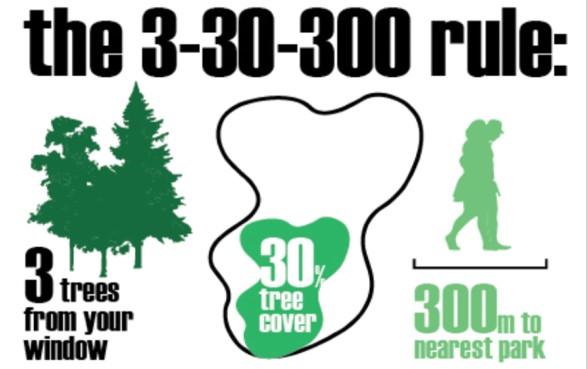
Sources and References
- Hill, D., Ruddick, J. and Walker, H. (2022). Valuing Belfast’s Urban Forest - Technical Report. Treeconomics Ltd. Last accessed: 13/07/2022. Available online: https:// www.treeconomics.co.uk/wp-content/uploads/2022/05/Belfast-i-Tree-Eco-report.pdf
- Konijnendijk, C. (2021) The 3-30-300 Rule for Urban Forestry and Greener Cities
- Segoviano, A. (1995). Belfast’s Trees - A survey of Trees in Greater Belfast.
- The Forest of Belfast Project The Forest of Belfast. (1994) A Strategy Document. The Forest of Belfast Project
Section 2 - Vision
“That Belfast is a city which focuses on protecting, enhancing and expanding its woodlands, hedges, and trees, connecting people to nature, and ensuring that these continue to be a major asset to everyone who lives in, works in, and visits our city.”
Vision
Although the Vision has a city-wide scope, it is important to work at the neighbourhood level, together with local communities and stakeholders, to ensure the successful implementation of the plan.
This new Tree Strategy is championed by Belfast City Council and Belfast One Million Trees, and was developed in a collaborative process over series of workshops with representatives of the local government; interest groups; and representatives of the community; and with the support of Treeconomics. The Strategy outlines key topics, priorities, and actions under three central themes:
- Trees and Forest Structure
- Community Framework
- Sustainable Resource Management Approach
The Strategy is structured around a comprehensive set of key performance indicators, informed by the current state of evidence and best practice. For each of these performance indicators, an assessment of the current situation is made, ambitions are laid out, and priorities are identified. Moreover, specific actions and roles and responsibilities are defined.
In addition, an initial public consultation was also undertaken as part of this strategy. The online survey questionnaire was one of the most popular posted by Belfast City Council with 615 respondents and 200 pages of feedback. Further details and highlights are provided in Appendix V.
This ambitious Tree Strategy is an important step forward. Its future implementation, with a co-ordination role for Belfast City Council and in collaboration with a wide range of local partners and members of the community, will make the city greener, healthier, and more resilient to climate and other challenges.
The table in Figure 2 lists some policies, strategies and initiatives of Belfast City Council and Central Government departments.
Figure 2: Belfast Tree Strategy and its relationship to other policies, strategies and initiatives of Belfast City Council and Central Government departments
|
Programme for Government |
Climate Change Act NI 2022 |
|---|---|
|
Regional Development Strategy |
|
|
Green Growth Strategy |
|
|
DAERA Forests for our Future Initiative |
|
|
Second Cycle Northern Ireland Flood Risk Management Plan 2021-2027 |
|
|
NI Climate Adaption Programme |
|
|
Strategic Planning Policy Statement |
|
|
Belfast Local Development Plan |
Belfast Agenda |
|
|
Belfast Resilience Strategy |
| One Million Trees Programme | |
|
|
Belfast Tree Strategy |
|
|
Net-Zero Carbon Roadmap |
Green and Blue Infrastructure Plan |
|
|
Belfast Open Spaces Strategy (BOSS) |
Potential Future Strategies |
|
Playground Improvement Plan |
Local Biodiversity Action Plan |
|
Tree Strategy Action Plan |
Habitats Strategy |
|
Cemeteries and Crematorium Improvement Programme |
Climate Action Plan |
| Gardens and Community Gardens and Allotments | |
| Watercourse and Bodies | |
| Landscape Character | |
| Playing Pitches Strategy | |
| Area and Neighbourhood Plans Interventions | |
| Site Based Management Plans Green Flag Management Plans |
|
Section 3 - Targets, Priorities and Actions
“It seems to me that we all look at Nature too much, and live with her too little”
Oscar Wilde
1.Trees and Urban Forest Structure
“Apart from the obvious environmental benefits of trees /shrubs ie cleaning the air by removing toxins, wildlife habitat, biodiversity. They also provide essential shade for walkers, cyclists, animals etc who frequent the area.”
Belfast Resident and consultation respondent
3.1 Targets, priorities and actions
T1 Relative Tree Canopy Cover
Tree Canopy Cover, which is often also referred to as tree cover or urban canopy cover, can be defined as the area of leaves, branches, and stems of trees covering the ground, across a given area, when viewed from above. Canopy cover is a two dimensional metric, indicating the spread of canopy cover across an area. Assessing canopy cover is popular because it is relatively simple to determine from a variety of means and it can be calculated at relatively little expense.
There are many methods of assessing canopy cover at this scale, including i-Tree canopy, i-Tree Eco, Sentinel satellite data, Bluesky National Tree Map, etc. These methods are not directly comparable with each other as they use different metrics and definitions of what constitutes canopy cover. Going forward Belfast will identify a suitable method of assessment so that repeat surveys are consistent and can be compared in order to track and monitor performance.
It has also been acknowledged that for any future assessment it will be important to be able to differentiate between the tree canopy cover also provided by Woodlands, Hedges, Parks, Open grown and Street trees.
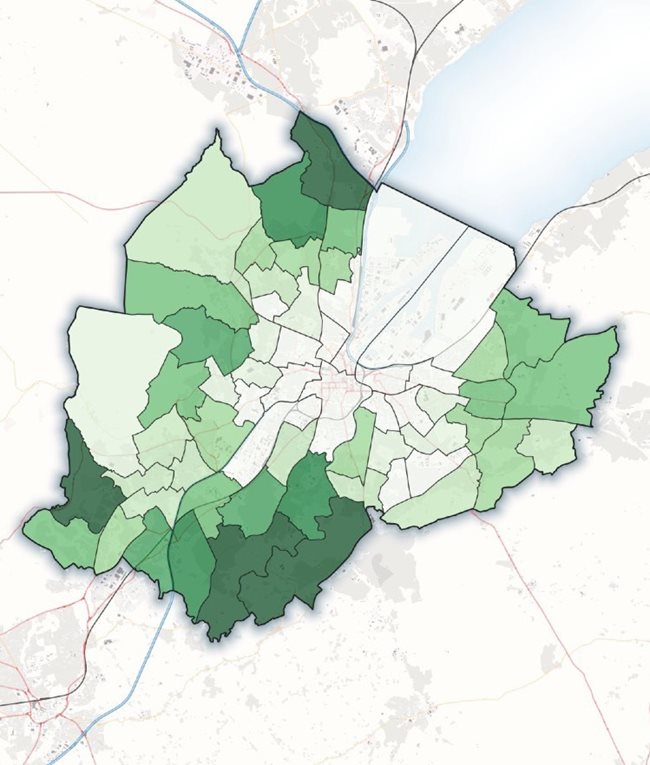
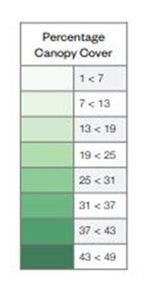
Figure 3: Belfast's Existing Canopy Cover Percentage by Ward measured with Sentinel Satellite Data
© OpenStreetMap contributors Contains OS data © Crown copyright and database right 2022.
© contains modified Copernicus Sentinel data (2017), processed by CBK PAN
Actions
- Carry out a detailed canopy cover assessment to establish accurate potential canopy cover and the amount of tree cover also provided by woodland and hedges.
- Review every 5 years by carrying out a canopy cover assessment.
Relevant corporate policies
| Priority | Responsibility for Action | For review |
|---|---|---|
| High | 1-2. Belfast City Council | To be confirmed - short term project |
| Current Performance Level | Performance Indicators | |||
|---|---|---|---|---|
| Moderate | Low | Moderate | Good | Optimal |
| The existing canopy cover equals 0–25 per cent of the potential. | The existing canopy cover equals 25–50 per cent of the potential. | The existing canopy cover equals 50–75 per cent of the potential. | The existing canopy cover equals 75–100 per cent of the potential. | |
T2 Size (Age) Diversity
A healthy urban forest relies on its age diversity to maintain its ability to provide constant benefits to the people who live in Belfast over time. Maturing trees must be protected and managed to ensure they thrive and survive to become veteran trees (senescent), and juvenile trees must be planted constantly to replace old trees, dying trees, and trees removed for safety reasons. Larger, older trees typically provide more annual benefits than smaller, younger trees. However, these younger trees are vital to maintaining a healthy and sustainable forest.
Generally, the most accurate way to gauge age diversity is to compare current tree size in each species (in terms of diameter at breast height, or DBH) to the maximum diameter for that species. The goal would then be to maintain a tree population that is unevenly distributed among different age classes, making sure that there are enough juvenile trees for the future.
It is of course also important to strive for age diversity across the entire tree population – including public trees managed “extensively” (as a group) in parks and natural areas, as well as trees on private property, both city-wide and at neighbourhood level.
The recent i-Tree Eco study for Belfast gives the current age diversity across all trees as: 67 per cent Juvenile, 24 per cent Semi - Mature, 8 per cent Mature and 1 per cent Senescent.
Figure 4: Richards “Ideal” Distribution of Tree Age Across the Urban Forest Showing Typical DBH for Each Age Class.
Sources and references:
Richards, N.A., (1982/1983). Diversity and stability in a street tree population. Urban Ecology 7, 159–171 – as cited in McPherson, Urban Forestry & Urban Greening 12 (2013) 134– 143.
Actions
- Review every 10 years
Relevant corporate policies
| Priority | Responsibility for action | For review |
|---|---|---|
| Medium | 1. Belfast City Council, Belfast Hills, One Million Trees | TBC - Medium term project |
| Current Performance Level | Performance Indicators | |||
|---|---|---|---|---|
| Moderate | Low | Moderate | Good | Optimal |
| Even age distribution or highly skewed toward a single age class. | Some uneven distribution, but most of the tree population falls into a single age class. | Total tree population across municipality approaches an ‘ideal’ age distribution of 40 per cent juvenile, 30 per cent semi-mature, 20 per cent mature, and 10 per cent senescent. | Total population approaches that ideal distribution borough-wide as well as at the ward level. | |
T3 Species Diversity
Diversity is an important aspect of the urban forest to monitor. Trees are split into families, genera, species and varieties and it is essential to have a mix of these to create a diverse urban forest. However, maintaining a high level of both inter- and intra- species diversity is also key to urban forest sustainability. Sufficient tree diversity can increase overall resilience in the face of biotic and environmental stresses and threats. A more diverse tree-scape is better able to deal with possible changes in climate or pest and disease impacts.
Understanding the species diversity of Belfast’s existing urban forest is a vital first step. From there, tree planting and management plans can enhance the diversity in line with the goals and KPI’s of the action plan. The recent i-Tree Eco study indicates that Belfast's top three most common species (Ash - 11 per cent, Sycamore - 9 per cent and Beech - 5 per cent) account for 25.8 per cent of the population.
Santmour’s (1990) 10-20-30 rule for species, genus and family, and Barker’s benchmark of 5 per cent per species are useful tools in assessing and providing targets for species diversity in the urban forest. Ideally, the array and location of suitable tree species would be so diverse that no single species would represent more than 5 per cent of the tree population across the municipality or more than 10 per cent in any given neighbourhood. However these rules apply only to street tree populations.
For landscape scale approaches Hubbell’s dominance diversity curves can be a more useful aid to visualise species diversity. The longer and shallower the curve, the greater the diversity.
Figure 5: Dominance diversity curves for UK cities compared with example forest types
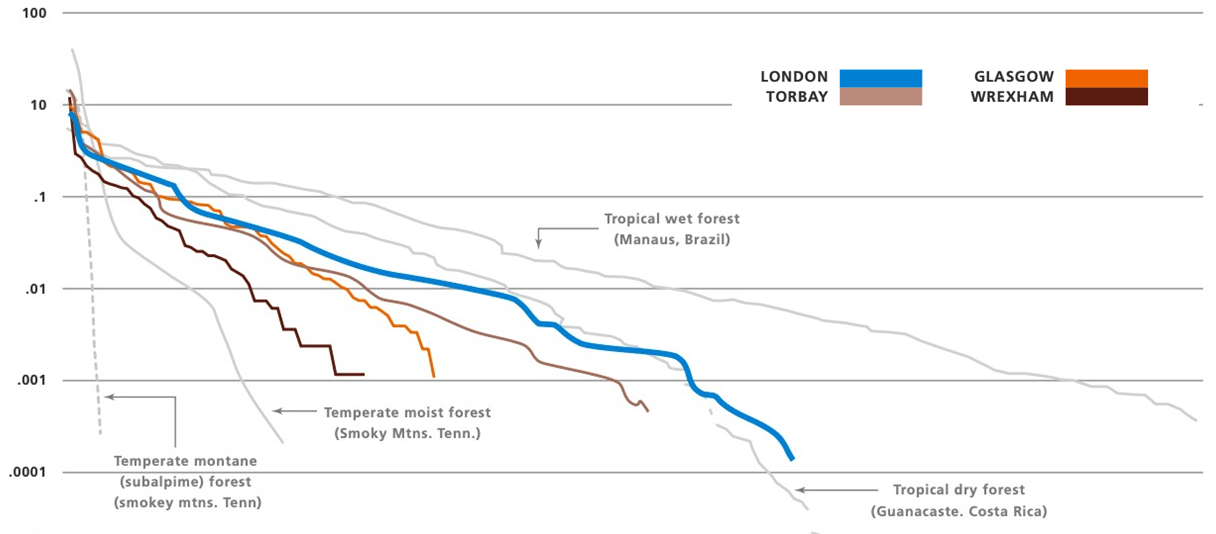
Sources and references:
Santamour, F.S. (1990) Trees for urban planting: Diversity, uniformity and common sense, in: Proceedings of the Conference Metropolitan Tree Improvement Alliance (METRIA). pp. 57–65.
Barker, P.A. (1975) Ordinance Control of Street Trees. Journal of Arboriculture. 1. pp. 121-215.
Beeauchamp, K. 2016 Measuring Forest Tree Species Diversity. Forest Research.
Rosindell, J., Hubbell, S.P. and Etienne, R.S., 2011. The unified neutral theory of biodiversity and biogeography at age ten. Trends in ecology & evolution, 26(7), pp.340-348.
Actions
- Assess Belfast’s street tree diversity to Santamour’s Rule and also across the entire urban forest using Hubbell’s dominance diversity curve method.
- Review every 10 years.
Relevant corporate policies
| Priority | Responsibility for action | For review |
|---|---|---|
| High | 1. Belfast City Council 2. Research Partner |
To be confirmed - short term project |
| Current Performance Level | Performance Indicators | |||
|---|---|---|---|---|
| Low | Low | Moderate | Good | Optimal |
| Five or fewer species dominate the entire tree population across municipality. | No single species represents more than 10 per cent of total tree population; no genus more than 20 per cent; and no family more than 30 per cent. | No single species represents more than 5 per cent of total tree population; no genus more than 10 per cent; and no family more than 15 per cent. | At least as diverse as “Good” rating (5/10/15) municipality-wide – and at least as diverse as “Moderate” (10/20/30) at the neighbourhood level. |
|
T4 Species Suitability
Species suitability involves selecting a broad array of species which are well suited to both the urban and regional environment.
Trees have unique needs; all tree species have different genetic characteristics and growth strategies which have been developed to maximise survival and growth in their natural habitats. Climate, soil, and other environmental aspects can affect their ability to survive and thrive. In cities, trees are subject to more external stresses than their woodland counterparts, and this can limit their lifespan and make them more susceptible to pests and disease. By promoting the planting of suitable species in suitable locations, trees are less likely to suffer from these stresses and therefore reach their full potential.
The determination of species suitability should take into account concerns such as adaptability to local climate and future climate change, invasive potential, soils, moisture demands, disease risk, and management considerations.
Checking plant hardiness zones is a good place to start. The USDA-designed system maps zones on minimum temperatures, and is now available for the rest of the world. Forest Research have developed a climate matching tool (https://www.forestresearch.gov.uk/tools-and-resources/fthr/climate-matching-tool/) which may be of some use in predicting future climates. FR’s Ecological Site Classification Decision Support System (ESC-DSS) found online at https://www.forestresearch.gov.uk/tools-and-resources/fthr/ecological-site-classification/ can indicate a trees suitability depending on a range of factors such as soil moisture and nutrient regime, climate and topography etc.
In the example opposite, species suitability has been mapped using multiple different layers in an interactive tree planting opportunity map which also displays potential carbon storage and sequestration.
Figure 6: Tool to show species suitability and carbon sequestration projections

Actions
- Assess species suitability across Belfast for a changing climate.
- Establish Native - Non-Native Guidelines for urban and rural areas.
- Explore how to include Intra Diversity.
Relevant corporate policies
| Priority | Responsibility for action | For review |
|---|---|---|
| Medium | 1-3. Belfast City Council | TBC - Medium to Long term project |
| Current Performance Level | Performance Indicators | |||
|---|---|---|---|---|
| Moderate | Low | Moderate | Good | Optimal |
| Fewer than 50 per cent of all trees are from species considered suitable for the area and for projected climate. | >50 per cent-75 per cent of trees are from species suitable for the area and for projected climate. | More than 75 per cent of trees are suitable for the area and for projected climate. | Virtually all trees are suitable for the area and for projected climate. | |
T5 Publicly Owned Trees
Trees managed individually, such as street trees, are considered to be “managed intensively,” according to arboricultural techniques – whereas trees in woodlands or other natural areas are typically “managed extensively,” as a group. Park trees or trees on institutional campuses can fall into either category, depending on how they are managed.
Understanding how many trees are managed in this way and what this type of management entails will help provide a baseline for improving future ‘intensive’ practices. A tree inventory documenting these trees, their location, species, health, etc is invaluable for tree maintenance and risk management.
Belfast already uses a tree inventory system for the street trees and those in parks. This includes detailed condition ratings and historic and planned maintenance. The next step is to migrate this system to a GIS based platform.
Figure 7: The street lined trees of Belfast

Actions
- Move to an integrated GIS based tree inventory system.
Relevant corporate policies
- Belfast Open Spaces Strategy
- Belfast Metropolitan Transport Plan
- Belfast Green and Blue Infrastructure Plan
| Priority | Responsibility for action | For review |
|---|---|---|
| Low | Belfast City Council | TBC - Medium term project |
| Current Performance Level | Performance Indicators | |||
|---|---|---|---|---|
| Good | Low | Moderate | Good | Optimal |
| Condition of urban forest is unknown. | Sample-based tree inventory indicating tree condition and risk level. | Complete tree inventory that includes detailed tree condition ratings. | Complete tree inventory that is GIS-based and includes detailed tree condition as well as risk ratings. | |
T6 Publicly Owned Woodlands and Natural Areas
Trees in woodlands or other natural areas are typically “managed extensively,” as a group whereas trees managed individually, such as street trees, are considered to be “managed intensively,” according to arboricultural techniques (See T5). Park trees or trees on institutional campuses can fall into either category, depending on how they are managed.
Understanding how many trees are managed in this way and what this type of management entails will help provide information for improving future ‘extensive’ practices.
Natural area surveys that incorporate patterns and structures of ecological functions would be useful. Woodland fragmentation, recreational overuse, disturbance and invasives such as Rhodedendron have all been highlighted as issues of serious concern, which are as yet unquantified.
Developing individual management plans and a web map for these areas could be a useful tool for both management, community engagement and connectivity. Current ‘extensive’ management methods should be reviewed and updated if necessary.
Figure 8: Priority habitats with high ecological importance across Belfast (Inset: Canopy cover by Ward)
Contains public sector information licensed under the Open Government Licence v3.0. Contains OS data © Crown copyright and database right 2022. © OpenStreetMap contributors

Actions
- Carry out benchmark surveys on the nature and extent of Natural areas including Woodland and Hedgerows and assess usage level and patterns, threats, ecology and function of these natural areas.
- Develop Targets, Priorities, Actions and KPI’s for these areas for inclusion in strategy documents and individual management plans. With an emphasis on connectivity. Connecting people to woodlands and connecting woodlands to other woodlands.
- Migrate woodland and other natural environment data to a webmap.
Relevant corporate policies
| Priority | Responsibility for action | For review |
|---|---|---|
| Low | 1-3. Belfast City Council | TBC - Medium term project |
| Current Performance Level | Performance Indicators | |||
|---|---|---|---|---|
| Good | Low | Moderate | Good | Optimal |
| No information about publicly owned natural areas. | Publicly owned natural areas identified in a “natural areas survey” or similar document or on webmap. | Survey document also tracks level and type of public use in publicly owned natural areas. | In addition, usage patterns, ecological structure and function of all publicly owned natural areas are also assessed and documented. |
|
T7 Trees on Private Property
Trees on private property are more difficult to survey and manage than those on public land due to the extent and inaccessibility of these trees. It relies on landowners taking an active role in tree management.
In addition to an i-Tree Eco sample based analysis, a detailed assessment of the Urban Tree Canopy which can be displayed on a city-wide basis should be carried out for optimal results.
A full inventory of trees on private properties may be a tall order, however many of Belfast’s trees will fall into conservation areas, and many more will be on record with a tree preservation order (TPO). Fully collating the data already held on these trees may be useful in combination with an i-Tree Eco sample survey.
Furthermore, the Bluesky National Tree Map (NTM) also provides an estimate of tree numbers and could be used in conjunction with OS mastermap to provide a point based assessment relatively quickly.
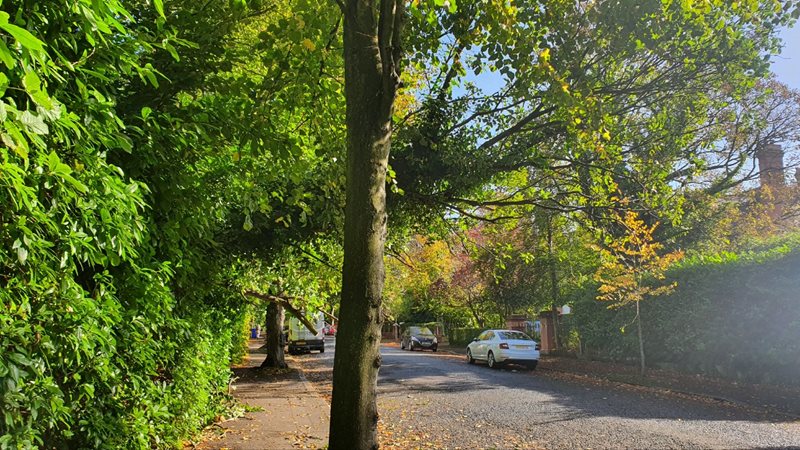
Actions
- Ongoing review and update of existing interactive maps for current TPO and Conservation sites.
Relevant corporate policies
| Priority | Responsibility for action | For review |
|---|---|---|
| Low | 1. Belfast City Council | TBC - Short to Medium term project |
| Current performance level | Performance Indicators | |||
|---|---|---|---|---|
| Good | Low | Moderate | Good | Optimal |
| No information about privately owned trees. | Aerial, point-based assessment of trees on private property, capturing overall extent and location. | Bottom-up, sample-based assessment of trees on private property, as well as basic aerial view (as described in “Fair” rating). | Bottom-up, sample-based assessment on private property, as well as a detailed Urban Tree Canopy (UTC) analysis of entire urban forest, integrated into municipality-wide GIS system. | |
T8 Other Elements of the Urban Forest - including Biodiversity
Other elements of the urban forest include shrubs, hedges, green walls and roofs, plants, wildlife, and water. These elements, along with trees, provide a wide range of benefits, including ecosystem services and amenity value.
Whilst shrubs, like trees, can be surveyed (for example as in the i-Tree Eco project), and green walls and roofs can be counted and measured, many of these other elements are very difficult to quantify, such as biodiversity for example. Assessing and quantifying these environmental impacts and services is even more complex. However, tools like the Urban Greening Factor (UGF) as used in London can provide a guideline and targets for urban greening.
In order to maintain and enhance the urban forest, Belfast needs to consider these other elements and to identify opportunities around new greening, biodiversity enhancement and development. This will help the city to make the most of its urban forest so that it continues to provide benefits to the community into the future in both a meaningful and quantifiable way.
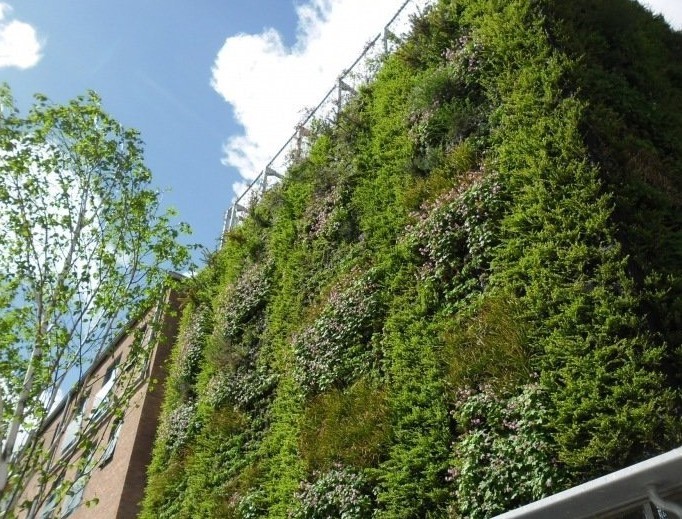
Vegetation grows on the external facade of the Skainos Centre on the Newtonards Road
Actions
- Information on these elements may be available from other third parties - needs enquiring, collating and reviewing find the gaps.
- Research and review current tools and best practices for measuring and quantifying these additional elements.
- Commit to developing a new biodiversity action plan.
Relevant corporate policies
| Priority | Responsibility for action | For review |
|---|---|---|
| Medium | 1-3. Belfast City Council | TBC - Short to Medium term project |
| Current Performance Level | Performance Indicators | |||
|---|---|---|---|---|
| Moderate | Low | Moderate | Good | Optimal |
| No information about other elements of the Urban Forest. | An assessment of existing elements of the urban forest has been carried out and a green infrastructure baseline has been established. | Establish relevant local UFG targets. Identify opportunities for new greening in development. | A relevant local UFG policy has been developed and implemented. Monitoring is ongoing. |
|
T9 Tree Benefits
Trees in cities bring with them both benefits and costs. Whilst many of the costs are well known, the benefits can be difficult to quantify or justify. Nevertheless, a considerable and expanding body of research exists on the benefits that urban trees provide to those who live and work in our cities, to green infrastructure and to the wider urban ecosystem.
Trees provide a ‘sense of place’, moderate extremes of high temperature in urban areas, improve air quality, reduce rainwater runoff, and act as a carbon sink. Yet, trees are often overlooked and undervalued. Understanding and valuing these services allows us to make more informed planting and management decisions for the benefit of current and future generations. It can also help communicate the importance of trees to the public and to those in the planning and development sector, encouraging the protection and management of existing trees as well as new planting.
i-Tree Eco is a tool which can be used to quantify tree benefits whilst also giving an overview of the structure of the urban forest. The random plot sample survey of Belfast provides a comprehensive analyse of the quantifiable tree benefits. Not all benefits are quantifiable, however amenity valuations (i.e. CAVAT) can help with valuing urban forests.
Belfast One Million Trees project conducted an i-Tree Eco valuation of the urban forest in 2022. The results of this study can be found at: https://www.treeconomics.co.uk/wp-content/uploads/2022/05/Belfast-i-Tree-Eco-report.pdf
About i-Tree
i-Tree is a suite of tools developed to assess the value of the urban forest and the ecosystem services provided which:
- Quantifies the benefits and values of trees around the world.
- Aids in tree and forest management and advocacy.
- Shows potential risks to tree and forest health
- Is based on peer-reviewed international research.
i-Tree Eco is an application designed to use field data from individual trees, complete inventories, or randomly allocated plots across the sample area to analyse the forest structure and ecosystem services provided.
Actions
- Resurvey in 10 years.
Relevant corporate policies
- Belfast Open Spaces Strategy
- Belfast Metropolitan Transport Plan
- Belfast Green and Blue Infrastructure Plan
| Priority | Responsibility for action | For review |
|---|---|---|
| Low | 1. Belfast City Council | 2032 |
| Current Performance Level | Performance Indicators | |||
|---|---|---|---|---|
| Optimal | Low | Moderate | Good | Optimal |
| No comprehensive information available about tree benefits in the city. | Some information available on key tree benefits, such as biodiversity. | Sound information available on a key set of tree benefits, such as biodiversity, recreation, environmental services. | Comprehensive information available on all tree benefits across the city. | |
T10 Wider Environmental Considerations
Belfast's urban forest has a vital part in the fight against climate change and can be part of both adaptation and mitigation strategies. Urban trees and woodlands are particularly important as a way of reducing the urban heat island effect, and in removing air pollution from built-up areas and highways. In certain situations, trees can also reduce the energy use of buildings by providing shade in summer (reducing the need for air conditioning) and insulation from cold winds in winter (reducing the heating costs).
With the UK target of carbon net neutrality by 2050, and Belfast's aims to achieve 66 per cent reductions on its 2000 level of emissions by 2025, 80 per cent by 2030, 88 per cent by 2035, 93 per cent by 2040, 97 per cent by 2045 and 100 per cent by 2050, the trees and other elements of the urban forest in Belfast are key.
Climate change poses a direct risk to the residents in Belfast; a warming climate increases risk of heatstroke, while increased rainfall will cause more frequent and more severe flooding. Biodiversity is also at risk, as species will struggle to adapt to warming climates, earlier springs and mild winters.
These considerations should be taken into account when managing the urban forest to ensure that the correct management practices are being enforces, tree and shrub species are as suitable to the future environment as possible, and that biodiversity is protected and enhanced, with biodiversity net gain as a key drive. Monitoring species and numbers will be important, and considering opinions from outside groups regarding more specific systems and locations will be key to preserving existing environments in Belfast. Working with the most up to date and location relevant climate and weather data is important to avoid generalisations and achieve the best results for the future.
Figure 9: Pollution of Particulate Matter <2.5 microns concentration across Belfast (Inset: Canopy Cover by Ward)
Source: UKAIR : Website: https://uk-air.defra.gov.uk/data/laqm-background-maps
Contains public sector information licensed under the Open Government Licence v3.0.
Contains OS data © Crown copyright and database right 2022.
© OpenStreetMap contributors
Actions
-
Complete an urban forest risk assessment to assess the risk from Flooding, Climate change, Pest and Diseases and others.
Relevant corporate policies
- Belfast Open Spaces Strategy
- Belfast Metropolitan Transport Plan
- Belfast Green and Blue Infrastructure Plan
| Priority | Responsibility for action | For review |
|---|---|---|
| Medium | 1. Belfast City Council with support from others | TBC - Medium term project |
| Current Performance Level | Performance Indicators | |||
|---|---|---|---|---|
| Moderate | Low | Moderate | Good | Optimal |
| No consideration/information that relates urban trees to climate change, air quality, water. | Some consideration of environmental aspects in relation to urban trees, e.g. looking at climate change. | Consideration of at least major environmental aspects in relation to urban trees. |
Full consideration of environmental aspects in relation to trees, based on comprehensive, state-of-the-art information. | |
Summary
| Key Performance Indicator | Current Performance Level (Low, Moderate, Good or Optimal) | Priority |
|---|---|---|
| T1 - Relative tree canopy cover | Good | High |
| T2 - Size (Age) diversity | Moderate | Medium |
| T3 - Species diversity | Moderate | High |
| T4 - Species suitability | Moderate | Medium |
| T5 – Publicly owned trees | Good | Low |
| T6 – Publicly owned natural areas | Good | Low |
| T7 – Trees on private property | Good | Low |
| T8 – Other elements of the UF; shrubs, hedges, green walls and roofs, plants, animals and water | Moderate | Medium |
| T9 – Tree benefits (including biodiversity) | Optimal | Low |
| T10 – Wider Environmental Considerations (including Climate Change, Air quality and Water | Moderate | Medium |
Targets, Priorities and Actions
3.2 Community Framework
“It is our collective and individual responsibility to preserve and tend to the environment in which we all live.”
- The Dalai Lama
“Trees are a natural thermo regulator. And a vital component of urban life. They provide a solution to
climate change, have economic, social, environmental and health benefits. They help wildlife and connect
communities.”Belfast Resident and consultation respondent
C1 Governance and Leadership
The aim of this target is to help all municipal departments and agencies within Belfast to communicate and cooperate to advance goals related to urban forest issues and opportunities. Belfast City Council will continue to work with other NGOs and agencies when necessary.
However, building a focussed network of urban forest partners to undertake co-ordinated action in delivery of this strategy would be desirable. The council will aim to work with a number of external partners to manage and maintain the urban forest. This may include, among others, The Woodland Trust, The Conservation Volunteers, Ulster Wildlife Trust, the Belfast Hills Partnership, the National Trust, the Department for Infrastructure (DfI), and the Department of Agriculture, Environment and Rural Affairs (DAERA).
Initially the council will undertake a review of whom the current stakeholders and actors are and where they are working across the city. It will then consider a map tree of stewardship across the city and will canvass opinion on wether to set up a Tree Forum as a means to strengthen and co-ordinate the governance and leadership of the urban forest.
Figure 10: Example Stew Map from New York which details which organisations work in which areas, their size, focus and overlap with others.
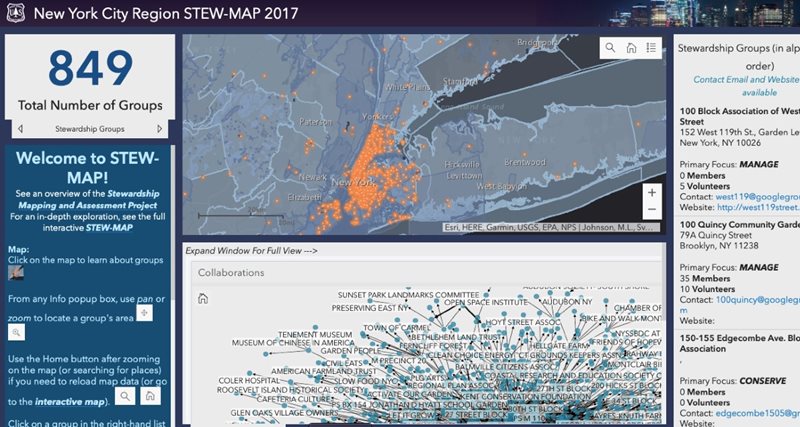
Actions
- Conduct a review of potential partners, schemes and community groups.
- Commission a database or stewardship map of Belfast.
- Evaluate setting up a Tree Forum.
Relevant corporate policies
| Priority | Responsibility for action | For review |
|---|---|---|
| Medium | 1-3. Belfast City Council | TBC -Medium to Long term project |
| Current Performance Level | Performance Indicators | |||
|---|---|---|---|---|
| Moderate | Low | Moderate | Good | Optimal |
| Agencies take actions impacting urban forest with no cross-departmental co-ordination, consultation or consideration of the urban forest resource. Leadership for UF management is fragmented. | BCC works with other NGOs and Agencies on ad-hoc projects as and when they arise. | BCC regularly and frequently works with other NGOs and Agencies to establish projects and plans.There is a cultural champion in place. | Integrated UF governance and leadership provided by a single dept and measured to plan that reflects local and international policies. | |
C2 Belfast Council Departmental Co-operation
This target aims to encourage all departments within BCC to consult and collaborate with the urban forest managers on issues relating to the urban forest. Regular communication across departments and agencies will be key to ensuring that the urban forest is considered to the fullest extent throughout the council. Key departments to incorporate into this network are public health, planning and development. Other key departments include education, housing and highways, which although external to the council, still need to be involved in the process.
Opening communication channels and interdepartmental teams can help to co-ordinate urban forest management by providing knowledge and guidance to all council departments when required in order to ensure that trees and green infrastructure are considered in full at all stages of decision-making.
Belfast Climate Commission and The Resilience Team are good examples of other BCC departments whose own strategies and objectives will overlap with the tree strategy.
Actions
- Set up dedicated interdepartmental/interagency working teams to facilitate the work packages arising from this strategy.
Relevant corporate policies
- Belfast Open Spaces Strategy
- Belfast Metropolitan Transport Plan
- Belfast Green and Blue Infrastructure Plan
| Priority | Responsibility for action | For review |
|---|---|---|
| Low | 1. Belfast City Council | TBC - Short term project |
| Current Performance Level | Performance Indicators | |||
|---|---|---|---|---|
| Good | Low | Moderate | Good | Optimal |
| Departments/agencies take actions impacting urban forest with no cross-departmental co-ordination, consultation or consideration of the urban forest resource. | Departments/agencies recognise potential conflicts and reach out to urban forest managers on an ad hoc basis – and vice versa. |
Informal teams among departments and agencies communicate regularly and collaborate on a project-specific basis. | UF policy implemented by formal interdepartmental/interagency working teams on all projects. | |
C3 Utilities Co-operation
C3 aims to ensure that all utilities – above and below ground – employ best management practices and cooperate with the city to advance goals and objectives related to urban forest issues and opportunities. This includes electric, gas, water, cable, telephone, fibre-optics, etc.
Utilities are required to follow certain standards for managing vegetation – including pruning branches, protecting roots, and performing overall management of trees and other vegetation that could impact their services, and city policies may also regulate certain utility management practices, such as overhead line clearance. Introducing and enforcing best practice standards which protect trees and other elements of the urban forest will be key, and collaboration with utilities could help advance the goals and objectives of the strategy.
Some utilities extend beyond the Belfast area. Figure 11 shows the water catchment areas which supply Belfast. These areas are not constrained by political boundaries, and this should be taken into account when assessing how the urban forest and utilities interact. Water companies will also be encouraged to develop systems in which trees provide a vital role in water management.
Figure 11: Hydrology of Belfast shown to extend beyond political boundaries (Inset: Canopy Cover By Ward)
Contains public sector information licensed under the Open Government Licence v3.0.
© OpenStreetMap contributors
Contains OS data © Crown copyright and database right 2022.
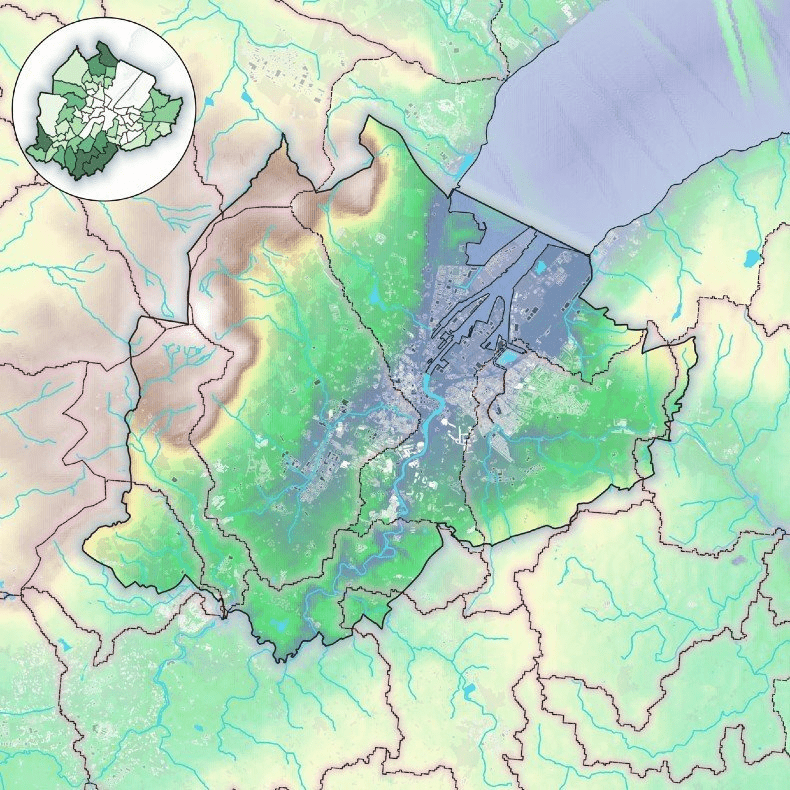
Actions
- Compile list of relevant utility providers and contacts.
- Set up formal initial engagement workshop with utility providers on trees in the built environment.
- Co-ordinate collaborative arrangements to meet the objectives of the plan (e.g. a tree charter that utilities can sign up to when they want to work on BCC land and training courses on trees for relevant employees in these utilities).
Relevant corporate policies
| Priority | Responsibility for action | For review |
|---|---|---|
| Medium | 1-3. Belfast City Council | TBC - Short term project |
| Current Performance Level | Performance Indicators | |||
|---|---|---|---|---|
| Moderate | Low | Moderate | Good | Optimal |
| Utilities take actions impacting urban forest with no council co-ordination or consideration of the urban forest resource | Utilities employ best management practices, recognise potential municipal conflicts, and reach out to urban forest managers on an ad hoc basis – and vice versa. | Utilities are included in informal council teams that communicate regularly and collaborate on a project-specific basis. | Utilities help advance urban forestry goals and objectives by participating in formal interdepartmental/interagency working teams on all municipal projects. | |
C4 Green Industry Co-operation
The “green industry” encompasses all professions and businesses that routinely support or engage in tree and vegetation management activities. Among others, these can include landscapers, nurseries, garden centres, contractors, maintenance professionals, tree care companies, landscape architects, foresters, planners, and developers.
BCC will work together with green industries to advance municipality-wide urban forest goals and objectives, and adhere to high professional standards. Close co-operation with the green industry presents an excellent opportunity for municipal urban forest managers to influence management of the forest resource on private property.
Actions
- List representatives and contact details for each relevant business or organisation.
- Co-ordinate collaborative arrangements to meet the objectives of the plan (e.g. a tree charter that businesses can sign up to if they want to collaborate with BCC on this plan). This should include discussions on skills building in the sector for Belfast and NI by looking at potential courses and apprenticeship schemes
Relevant corporate policies
| Priority | Responsibility for action | For review |
|---|---|---|
| Moderate | 1-2. Belfast City Council | TBC - Short term project |
| Current Performance Level | Performance Indicators | |||
|---|---|---|---|---|
| Moderate | Low | Moderate | Good | Optimal |
| Little or no cooperation among segments of green industry or awareness of municipality-wide urban forest goals and objectives. | Some cooperation among green industry as well as general awareness and acceptance of municipality-wide goals and objectives | Specific collaborative arrangements across segments of green industry in support of municipality-wide goals and objectives. | Shared vision and goals and extensive committed partnerships in place. Solid adherence to high professional standards. | |
C5 Involvement of Large Private and Institutional Landholders
As a large proportion of land within cities is owned by private individuals, organisations and institutions, enlisting their help in enhancing and protecting the urban forest is paramount. Outreach programs, management plans and funding strategies will help to incorporate these landholders. Communicating the benefits of trees will help inspire landholders and institutions to invest time and money in natural resources.
The goal is to help large private landholders embrace and advance city-wide urban forest goals and objectives by implementing specific resource management plans so that they can manage trees on their property in the most beneficial way.
Belfast's One Million Trees program is an example of an initiative which could be used to guide the development and achievement of this target. The Woodland Trust, Trees for Cities and The Tree Council of Northern Ireland all have good resources on engaging third parties on tree planting and maintenance standards and techniques that can forward this target. There is also more that could be done to collaborate with large institutions, although many already are part of the Belfast One Million Trees Partnership. For example the National Trust, Universities, Belfast Harbour, Crown Estate, DfC, NIHE, Housing Associations, DfI and the Education Authority are all examples of large active organisations in the city centre.
There’s also a suite of supplementary planning guidance for large developers which includes the;
- Planning and Flood Risk SPG,
- Trees and Development SPG and
- Sustainable Urban Drainage SPG.
Figure 12: Map showing Belfast’s Queen’s University Campus and the surrounding green spaces outlined in red
Contains OS data © Crown copyright and database right 2022.
© OpenStreetMap contributors

Actions
- Create database of larger landholders and contact details for each.
- Co-ordinate collaborative arrangements to meet the objectives of the plan.
- Communicating about e.g. health benefits to support partnerships and enhance tree protection.
Relevant corporate policies
| Priority | Responsibility for action | For review |
|---|---|---|
| Medium | 1 and 3. Belfast City Council 2. One Million Trees Project |
TBC - Short term project |
| Current Performance Level | Performance Indicators | |||
|---|---|---|---|---|
| Moderate | Low | Moderate | Good | Optimal |
| Large private landholders are generally uninformed about urban forest issues and opportunities. | Belfast conducts outreach directly to landholders with educational materials and technical assistance, providing clear goals and incentives for managing their tree resource. | Landholders develop comprehensive tree management plans (including funding strategies) that advance municipality-wide urban forest goals. | As described in “Good” rating, plus active community engagement and access to the property’s forest resource. | |
C6 Community Involvement and Neighbourhood Action
At the neighbourhood level, communities and residents groups will be encouraged to participate and collaborate with BCC and its partnering Non-Governmental Organisations (NGOs) in urban forest management activities.
Collaborating with smaller community groups such as volunteers, schools and charity groups can encourage further community involvement with projects in small neighbourhoods and wider district areas, which would benefit the whole city. Neighbourhood activities often help the community members to connect more with their urban forest, and encouraging communities to get involved will reduce the likelihood of conflict or opposition to tree planting.
Creating an interactive Stewardship Mapping and Assessment Project (STEW-MAP) such as those completed in Paris and New York may be a useful tool for engaging the public. It is a research methodology, community organising approach and partnership mapping tool developed by the USDA which shows who is responsible for the local environment. It has never been done in the UK and could be an invaluable tool to engage local residents and establish a network of UF management teams across the city.
Introducing a new Tree Warden program for Belfast is potentially a great way to encourage volunteers and community engagement. Belfast will seek to set up a tree wardens scheme over the course of the next 5 years.
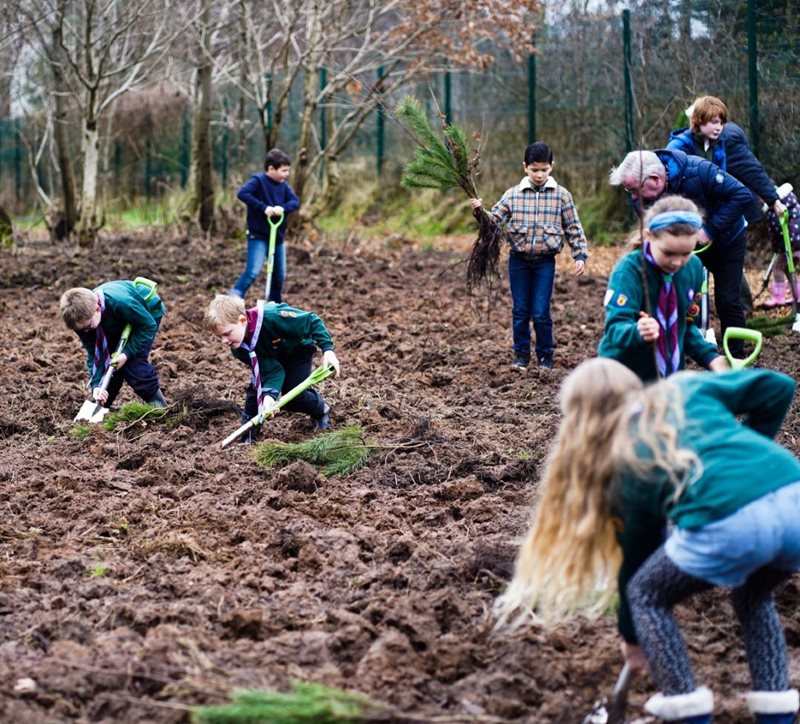
Actions
- List reps and contact details for key groups.
- Assess potential for creating stewardship map/mapping of community groups.
- Explore opportunities for a tree equity map.
- Link to other, wider initiatives and awards.
- Publicise events and launches.
- Agree proposals and co-ordinate the planting of living Christmas trees within the city.
Relevant corporate policies
- Belfast Open Spaces Strategy
- Belfast Metropolitan Transport Plan
- Belfast Green and Blue Infrastructure Plan
| Priority | Responsibility for action | For review |
|---|---|---|
| Low | 1-6. Belfast City Council and NGO could set this up and get funding - done previously by Conservation Volunteers. NGOs will need support for funding though and can't be seen as ‘offloading’ | TBC - Short to Medium term project |
| Current Performance Level | Performance Indicators | |||
|---|---|---|---|---|
| Good | Low | Moderate | Good | Optimal |
| Little or no citizen involvement or neighbourhood action. | At the neighbourhood level, citizens participate and groups collaborate with Belfast and/or its partnering NGOs in urban forest management activities to advance municipality-wide plans. | Some neighbourhood groups engaged in advancing urban forest goals, but with little or no overall co-ordination with or direction by municipality or its partnering NGOs. | Many active neighbourhood groups engaged across the community, with actions co-ordinated or led by municipality and/or its partnering NGOs. | |
C7 General Appreciation of Trees as a Community Resource
In order for the strategy to be a true success, one of its legacies should be that the people of Belfast love, respect and appreciate its trees. By engaging and encouraging the community in this way, it can be ensured that the urban forest will be protected and enhanced for generations to come. Changing peoples values can be difficult, but through education, celebration and engagement, the hope is that people will come to value the trees around them and the wider part which they play in the health of the city, the nation, and the world.
Not only local communities, but also stakeholders from all sectors and constituencies within the city – private and public, commercial and nonprofit, entrepreneurs and elected officials, community groups and individual citizens – should understand, appreciate, and advocate for the role and importance of the urban forest as a crucial community resource.
“Having public agencies, private landholders, the green industry, and neighbourhood groups all share the same vision of the city’s urban forest is a crucial part of sustainability. This condition is not likely to result from legislation. It will only result from a shared understanding of the urban forest’s value to the community and commitment to dialogue and cooperation among the stakeholders.”
Clark et al., 1997
Figure 13: Tree Tag Examples
Sources and references:
Clark, J.R., Matheny, N.P., Cross, G. And Wake, V. (1997). A Model of Urban Forest Sustainability. Journal of Arboriculture. Volume: 23. Issue: 1
Actions
- Investigate setting up a local tree awards scheme.
- Review methods for gauging and measuring this target.
Relevant corporate policies
- Belfast Open Spaces Strategy
- Belfast Metropolitan Transport Plan
- Belfast Green and Blue Infrastructure Plan
| Priority | Responsibility for action | For review |
|---|---|---|
| Medium | 1-2. Belfast City Council | TBC - Short to Medium term project |
| Current Performance Level | Performance Indicators | |||
|---|---|---|---|---|
| Moderate | Low | Moderate | Good | Optimal |
| General ambivalence or negative attitudes about trees, which are perceived as neutral at best or as the source of problems. Actions harmful to trees may be taken deliberately. | Trees generally recognised as important and beneficial. | Trees widely acknowledged as providing environmental, social, and economic services – resulting in some action or advocacy in support of the urban forest. | Urban forest recognised as vital to thecommunity’s environmental, social, and economic well-being. Widespread public and political support and advocacy for trees, resulting in strong policies and plans that advance the viability and sustainability of the entire urban forest. | |
C8 Regional Collaboration
As a leader in NI green infrastructure and urban forest management it is important that Belfast reaches out to neighbouring towns, cities, and municipalities to encourage collaboration, cooperation and innovation of the urban forests across the region and the country. In supporting its neighbours, Belfast can help provide much-needed guidance and advice by creating a communication network, and in doing so, secure the future of many smaller areas.
The Million Trees Project aims to plant one million native trees across Belfast by 2035. Already, 63,000 trees have been planted in Belfast and the surrounding city regions. This is a vast undertaking which requires regional collaboration and communication to succeed in the given timeframe.
Community initiatives could provide an invaluable opportunity to promote the progress made by the city in terms of urban greening and green infrastructure.
Widely publicising events all year round such as National Tree Week (usually in late November to early December), Arbor Day, planting days (winter time) and outdoor events, will bring focus onto Belfast’s urban forest, and encourage visitors from the surrounding areas.
Belfast supports the creation of nature recovery network in order to reverse the decline of biodiversity and enable nature's recovery at scale. The National Trust, the Woodland Trust, Ulster Wildlife, and RSPB, recently partnered on a project to build capacity to deliver a Nature Recovery Network in Northern Ireland. Belfast's urban forest will have an important role to play in the development of the network creating corridors and joining up habitat for wildlife.
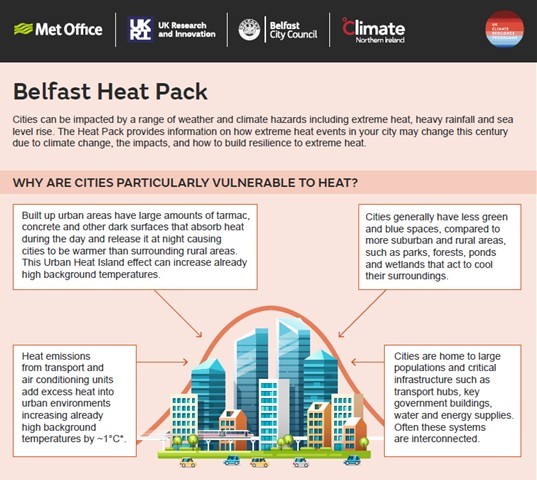
Actions
- Work with BCC Comms team to be made aware of the plan and its ongoing initiatives.
Relevant corporate policies
| Priority | Responsibility for action | For review |
|---|---|---|
| Low | 1. Belfast City Council | 5 years |
| Current Performance Level | Performance Indicators | |||
|---|---|---|---|---|
| Good | Low | Moderate | Good | Optimal |
| Const. and Wards have no interaction with each other or the broader region. No regional planning or co-ordination on urban forestry. | Some neighbouring municipalities and regional agencies share similar policies and plans related to trees and urban forest. | Some urban forest planning and cooperation across municipalities and regional agencies | Widespread regional cooperation resulting in development and implementation of regional urban forest strategy. | |
C9 International Reputation
To bring Belfast to the forefront of urban forestry both in the UK and internationally, it should aim to become a part of international schemes. The Biophilic City Network (https://www.biophiliccities.org/ birmingham-uk) and Tree Cities of the World (https://treecitiesoftheworld.org) are world renowned programs which certify that the city has achieved -and continues to work towards- a diverse and healthy urban forest.
These internationally recognised titles help to promote understanding that the urban forest and the management of it, is of a recognised and high international standard. With the Million Trees Project underway, Belfast’s reputation of being a 'green' city is growing, and the city should aspire to join such initiatives.
Not only will Belfast push to achieve these international initiatives, it shall endeavour to lead by example and provide guidance to other cities worldwide. To succeed in this, Belfast should promote its successes and continue to innovate its forest management strategies and GI development plans.
In will do this by working to this plan, actively promoting itself as a ‘green' city, continuing to learn and engage with new best practices, sharing knowledge and its successes, such as the Million Trees Campaign.
Figure 14: The Dalai Lama planting a tree in Belfast in 2000
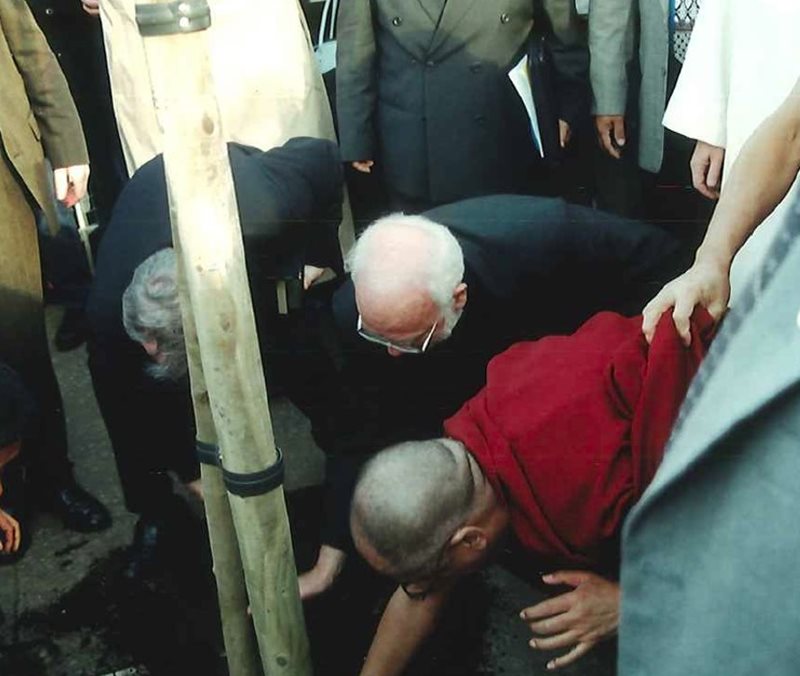
Actions
- Research Urban Forest International initiatives, awards and schemes and review which may be suitable for application.
Relevant corporate policies
- 2030 Agenda for Sustainable Development
- FAO Green Cities Initiative
- UN Habitat - The New Urban Agenda
| Priority | Responsibility for action | For review |
|---|---|---|
| Medium | 1. Belfast City Council | TBC - Medium term project |
| Current Performance Level | Performance Indicators | |||
|---|---|---|---|---|
| Moderate | Low | Moderate | Good | Optimal |
| There is no vision - aspiration or consideration of Belfast as an UF of International reputation. | Belfast is sometimes considered for its leadership in international contexts, based on specific efforts and projects | Belfast has signed up to international programs such as Tree cities of the World and the Biophilic City Network and makes good use of these networks to further its UF program. | Belfast is regarded as an international example and leader in its UFM and is prominent on the international stage as a UF city. | |
Summary - Community Framework
| Key Performance Indicator | Current Performance Level (Low, Moderate, Good or Optimal) | Priority |
|---|---|---|
| C1 - Governance and leadership | Moderate | Medium |
| C2 - Belfast Council departmental cooperation | Good | Low |
| C3 - Utilities cooperation | Moderate | Medium |
| C4 - Green industry cooperation | Moderate | Medium |
| C5 - Involvement of large private and institutional landholders | Moderate | Medium |
| C6 - Community involvement and neighbourhood action | Good | Low |
| C7 - General appreciation of trees as a community resource | Moderate | Medium |
| C8 - Regional collaboration | Good | Low |
| C9 - International Reputation | Moderate | Medium |
4. Sustainable Resource Management Approach
“Someone's sitting in the shade today because someone planted a tree a long time ago”
Warren Buffet
“A co ordinated approach with appropriate upkeep would ensure the City will benefit from a healthier and greener environment.”
Belfast Resident and consultation respondent
R1 Tree and Woodlands Inventory
A tree and woodland inventory involves taking stock of the individual trees within the urban forest. It is time and labour intensive to compile a full tree inventory of all trees, and would be unrealistic to achieve. However, plot/sample based inventories of woodland areas, combined with existing street and park tree inventories are a good place to start.
BCC should continue to build upon its existing tree inventory datasets for parks and street trees. It is important to ensure that data is uniform, both in its methods of collection and its format so that it can easily be compared from ward to ward, and over time.
Compiling the inventories of Belfast’s trees into a single portal or system, would be an essential starting point to establish the structure of the urban forest, including the number of trees, diversity of species, and age distribution of council owned trees. This is important as a baseline from which to monitor future progress and from which to manage the tree stock.
Although an i-Tree Eco study has been completed, this gives an overview of the total urban forest both public and private. Though vital, this is not representative of the council managed trees, and therefore decisions on species, health and management may differ. Ideally, in time Belfast will know the complete structure of the urban forest as a whole, and also by ward across the city.
Actions
- Review current Tree Management software and update if required with additional data on Street Trees and Woodlands.
- Investigate wether it will be possible and feasible to include hedges and hedgerows within a tree management system.
Relevant corporate policies
- UK’s Nationally Determined Contribution
- The UK Climate Change Act
- The 25 Year Environmental Plan
- Clean Air Strategy
- Clean Growth Strategy
| Priority | Responsibility for action | For review |
|---|---|---|
| Low | 1. Belfast City Council | TBC - Medium - Long term project |
| Current Performance Level | Performance Indicators | |||
|---|---|---|---|---|
| Good | Low | Moderate | Good | Optimal |
| No inventory. | Complete or sample-based inventory of publicly owned trees. | Complete inventory of publicly owned trees and sample-based privately owned trees that is guiding management decisions. | Systematic comprehensive inventory system of entire urban forest – with information tailored to users and supported by mapping in municipality-wide GIS system. | |
R2 Tree Valuation and Asset Management Approach
Tree valuation is an important part of managing and promoting the urban forest. With the trees valued, local people can understand the value of trees beyond the material worth. With these figures to hand, advocating for trees becomes easier. 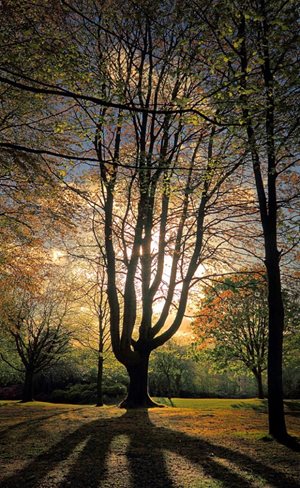
Capital Asset Valuation of Amenity Trees (CAVAT) was developed by the London Tree Officers Association (LTOA) and others in 2008. It is one of the principal methods of tree valuation in the UK, and aims to provide a method for managing trees as assets rather than liabilities. It can be used for individual trees or for the tree stock as a whole. Documents related to CAVAT including a user guide and the spreadsheet calculator can be viewed online at: https://ltoa.org.uk/documents-1/capital-asset-value-for-amenity-trees-cavat.
CAVAT is already used and built into policy to ensure trees are viewed positively. In Belfast, a CAVAT valuation was done as part of the i-Tree Eco project, which indicated that the total amenity value of Belfast’s trees is around £4.64 billion. Understanding this figure at ward level would be the next step, and an inventory to the council owned trees in each ward would be the first step.
The Species with the highest CAVAT Values are Acer pseudoplatanus (Sycamore), Fagus Sylvatica (Beech), Chamaecyparis Lawsoniana (Lawson’s cypress). The most common species of tree in Belfast’s urban forest is Fraxinus excelsior (ash), 10 per cent of the population in the urban area). The average condition of ash trees surveyed in the urban area was 65 per cent, while the average condition of sycamores surveyed in the urban area was 86 per cent, resulting in their high public amenity value.
The tree with the single highest amenity value is a common beech in the grounds of Queen’s University Belfast, with a CAVAT value of £158,000. The tree is in a woodland, has a stem diameter of over 100 cm, and is in good condition.
The CAVAT system is only really appropriate when applied to individual trees that are visible to the public. Furthermore, the i-Tree results are sample based and Belfast's individual woodlands are currently not subject to an asset valuation. These knowledge gaps will be addressed in the future.
Actions
- Add the CAVAT valuation to the council tree inventory system when it is updated.
Relevant corporate policies
| Priority | Responsibility for action | For review |
|---|---|---|
| Low | 1-2. Belfast City Council | TBC - Medium term project |
| Current Performance Level | Performance Indicators | |||
|---|---|---|---|---|
| Good | Low | Moderate | Good | Optimal |
| Tree valuation nor assessment management are in place. | Some form of tree valuation is used, at least for key projects involving public trees. | Tree valuation and asset management are implemented across the city, for most public trees. |
Tree valuation and asset management are implemented for all public trees - and in some cases also private trees. | |
R3 Canopy Cover Assessment and Goals
Assessing canopy cover is vital, as this metric is used frequently as a figure which is clear and easy to compare with other areas. Whilst canopy cover is not a thorough study of the health and diversity and therefore overall benefit of the urban forest, it is an important aspect which should not be overlooked simply for its simplicity.
This target involves assessing the existing canopy cover in detail, and setting goals based on reasonable potential canopy cover and achievable steps to maximising cover. This leads into T1-‘Relative Tree Canopy Cover’- and would provide the necessary baseline for achieving that target. It is important that any tree canopy target is achievable within a reasonable time frame, and considered within the wider context of the strategy.
Belfast has a target of Carbon net neutrality by 2050, and an increase in canopy cover would contribute immensely. The IUCN Urban Alliance suggest a 30 per cent tree canopy cover target, which has been adopted by many cities around the world. Belfast will adopt this target but needs to set a realistic time frame for when it will be achievable.
It should also be noted that tree planting does not necessarily provide an instant increase to canopy cover; in an urban setting trees are constantly being felled for any number of reasons, so insufficient planting can contribute to making up the deficit without actually increasing canopy cover. Therefore although the Million Trees project will be a much-needed boost of Belfast's canopy cover, an assessment of other available plantable space will also need to be carried out.
Figure 15: Tree Canopy Cover shown in green across Belfast from Sentinel Satellite data (Inset: Canopy Cover by Ward)
© OpenStreetMap contributors
Contains OS data © Crown copyright and database right 2022.
© contains modified Copernicus Sentinel data (2017), processed by CBK PAN
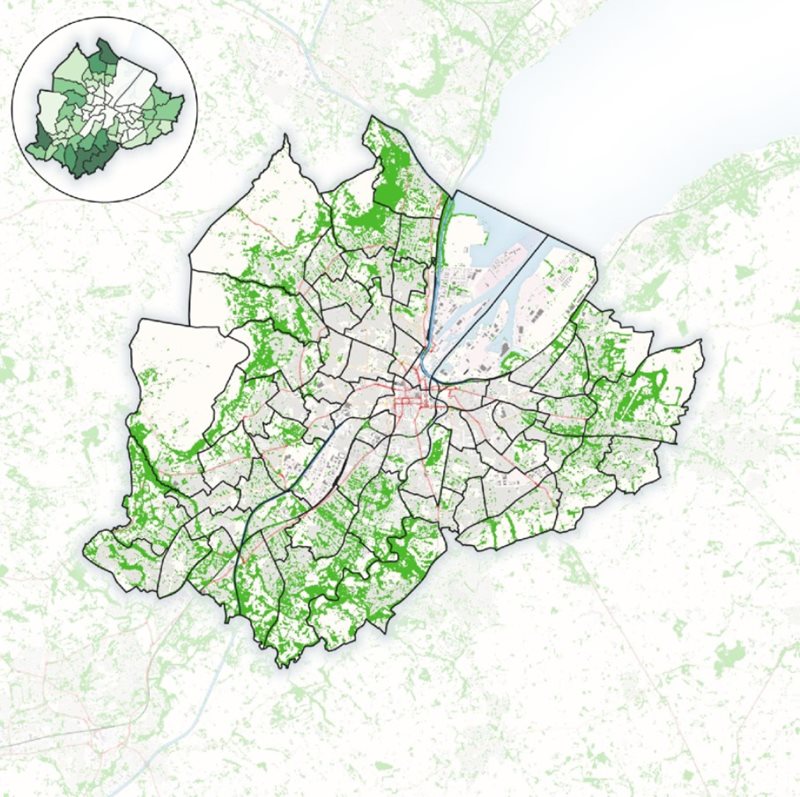
Actions
- Map canopy at the ward level using high resolution data for ward or neighbourhood canopy cover metrics. Where possible differentiate between tree and woodland cover.
- Assess potential plantable space and model canopy growth and planting scenarios to determine suitable timeframe for 30 per cent tree cover.
Relevant corporate policies
| Priority | Responsibility for action | For review |
|---|---|---|
| Medium | 1-2. Belfast City Council | TBC - Medium to Long term project |
| Current Performance Level | Performance Indicators | |||
|---|---|---|---|---|
| Moderate | Low | Moderate | Good | Optimal |
| No assessment or goals. | Low-resolution and/or point-based sampling of canopy cover using aerial photographs or satellite imagery – and limited or no goal-setting. | Complete, detailed, and spatially explicit, high-resolution Urban Tree Canopy (UTC) assessment based on enhanced data (such as LiDAR, Satellite or NTM) – accompanied by comprehensive set of goals by land use and other parameters. | As described for “Good” rating – and all utilized effectively to drive urban forest policy and practice municipality-wide and at neighborhood or smaller management level. | |
R4 Tree Equity
The urban forest should reflect the diversity of people and cultures at a neighbourhood level, and planting and management should respect the views and values of the many different communities it serves. BCC aims to progress equality in all spheres of social and economic life and empower and engage neighbourhoods.
Urban forests are connected to a range of socio-economic factors, with studies linking canopy cover to health, wealth, education, and crime. Typically, lower income areas have fewer trees, and this inequality should be addressed across Belfast. Lack of tree canopy cover can also be linked to the level of urban intensification and lack of physical space to plant trees (low-cost housing with small gardens are not always suitable for trees). Therefore utilising other aspects of the urban forest such as green walls/roofs may be a part of the solution. The benefits of trees should be made available to all people in all areas of the city.
Belfast will recognise that trees and green space should be a right for all people, and environmental exclusion must be avoided.
This target aims to ensure that the planting and management of the urban forest can be focussed in the areas where it will most benefit the local people, by increasing planting in the areas with the lowest canopy cover. Tree management plans in these areas should include community engagement and neighbourhood outreach to maximise the benefits of trees in the area. The multi-faceted meanings of trees to different people should be recognised.
Figure 16: Indices of Multiple Deprivation ranking by ward (Inset: Canopy Cover by Ward)
Source: NISRA : Website: www.nisra.gov.uk
Contains public sector information licensed under the Open Government Licence v3.0.
Contains OS data © Crown copyright and database right 2022.
© OpenStreetMap contributors

Sources and references:
BCNUEJ, (2021). Policy and Planning Tools for Urban Green Justice-Fighting displacement and gentrification and improving accessibility and inclusiveness to green amenities.
Nesbitt, L., Meitner, M.J., Sheppard, S.R. and Girling, C., (2018). The dimensions of urban green equity: A framework for analysis. Urban forestry & urban greening, 34, pp.240-248.
Actions
- Consider a Tree Equity map for Belfast and focus efforts around tree planting and community engagement in the areas that most need it.
Relevant corporate policies
| Priority | Responsibility for action | For review |
|---|---|---|
| Medium | 1. Belfast City Council | TBC - Medium to long term project |
| Current Performance Level | Performance Indicators | |||
|---|---|---|---|---|
| Moderate | Low | Moderate | Good | Optimal |
| Tree planting and outreach is not determined equitably by canopy cover or need for benefits. | Planting and outreach includes attention to low canopy neighbourhoods or areas. | Planting and outreach targets neighbourhoods with low canopy and a high need for tree benefits. | Equitable planting and outreach at the neighbourhood level is guided by strong citizen engagement in those low-canopy/ high-need areas. | |
R5 Reviewing and Improving the Tree Strategy
Belfast is taking a strategic approach to its urban forest, and engaging experts and key stakeholders to help it prepare this Tree Strategy. It follows an action based model more widely used in countries like the US and Canada. The Plan will help Belfast set and work towards a vision for its trees that is sustainable well into the future.
The Tree Strategy outlines a vision for the development of the urban forest. It is area-specific and outlines the aspirations of all stakeholders who enjoy its benefits. It provides a long-term framework in which strategic plans can be developed. Tree-planting programmes are just one element of urban forest management, and long-term management plans are just as important. With an urban forest management plan in place, tree planting programs can be focused and strategised, as well as better guiding the achievement of a long-term vision.
With agreement on an ambitious vision, the Tree Strategy can be divided into management periods, with goals and targets clearly outlined. A series of performance indicators are then be put into place to monitor performance and help progress towards the achievement of goals and the wider vision. It is important that progress is monitored and reviewed on a regular basis, and actions modified as necessary. This way, Belfast can focus on the most relevant and urgent areas going forward.
The Tree Strategy is an ongoing piece of work and this document represents the first step in a new chapter for Belfast’s urban forest, and this plan will be subject to ongoing improvement and updating.
For each and every target within the plan further detail will be added, projects will be planned and actioned to take Belfast towards its vision.

Actions
- Annual Review of this plan.
Relevant corporate policies
| Priority | Responsibility for action | For review |
|---|---|---|
| Medium | 1. Belfast City Council | TBC - Medium to long term project |
| Current Performance Level | Performance Indicators | |||
|---|---|---|---|---|
| Moderate | Low | Moderate | Good | Optimal |
| No plan. | Existing plan limited in scope and implementation. | Recent comprehensive plan developed and implemented for publicly owned forest resources, including trees managed intensively (or individually) and those managed extensively, as a population (e.g., trees in natural areas). | Strategic, multi-tiered plan with built-in adaptive management mechanisms developed and implemented for public and private forest resources. | |
R6 Urban Forestry Funding
Urban forestry in Belfast has largely been funded by Belfast City Council, but it is important to not only secure and grow local municipal funding, but also to expand and diversity finances for urban forestry.
There are several government schemes for funding tree planting of different types, from woodland establishment to urban forestry.
Whilst funding for tree planting is readily available, funding for management and monitoring of the urban forest needs further investigation.
Private-sector funding as well as funding from one-off projects offer additional opportunities. Moreover, as a large share of Belfast’s urban forest is owned by private residents and organisations their involvement and support is also essential.
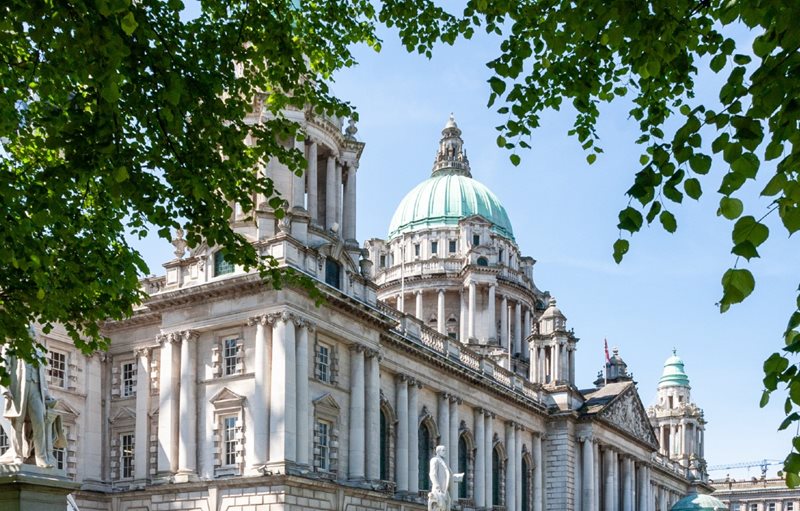
Actions
- Complete a Cost Benefit Analysis on Belfast's Urban Forest.
- Ensure Woodlands are included in any budgeting and resource planning.
- Cost up the actions arising from this strategy and seek budget to enable it to be actioned.
- Aim to secure a proportion of funding in the next financial year from private sources (including partnership projects eg - Million Trees).
Relevant corporate policies
| Priority | Responsibility for action | For review |
|---|---|---|
| Low | 1-4. Belfast City Council | TBC - Medium to long term project |
| Current Performance Level | Performance Indicators | |||
|---|---|---|---|---|
| Good | Low | Moderate | Good | Optimal |
| Little or no dedicated funding. | Funding only for emergency, reactive management. | Funding sufficient for some proactive management based on urban forest management plan. | Sustained funding from public and private sources to fully implement comprehensive urban forest management plan. | |
R7 Urban Forestry Program Capacity and Staffing
Adequate staffing means there are enough staff with the correct training and experience to carry out all necessary tasks relating to the implementation and day-to-day running of the urban forestry programme. This may mean hiring new staff or arranging further training for current staff.
This includes anyone involved in the delivery of tree management and implementation, e.g., Tree Wardens and other volunteers, Tree Officers, Parks and countryside staff, etc.
One of the key limiters of this target is money, therefore fully costing the Tree Strategy and establishing a dedicated and co-ordinated budget is the first step.
A fully costed budget to deliver this plan can be used to help obtain the necessary funding to deliver the plan. This funding would then allow for the important longer term work, such as researching metrics for biodiversity, integrating hedges and hedgerows into the tree management software as well as building the trees wardens scheme and volunteer network too.
Actions
- After costing this plan draft up the program capacity including staffing.
Relevant corporate policies
| Priority | Responsibility for action | For review |
|---|---|---|
| Low | 1. Belfast City Council | TBC - Medium to long term project |
| Current Performance Level | Performance Indicators | |||
|---|---|---|---|---|
| Good | Low | Moderate | Good | Optimal |
| Team severely limited by lack of personnel and/or access to adequate equipment. Unable to perform adequate maintenance, let alone implement new goals. | Team limited by lack of trained staff and/or access to adequate equipment. | Team able to implement many of the goals and objectives of the urban forest management plan. | Team able to implement all of the goals and objectives of the urban forest management plan. | |
R8 Tree Establishment Planning and Implementation
Tree planting is more complex than most people realise; it is more than simply sticking trees in the ground. In order to ensure the trees survive, thrive and reach their full potential in cities, the right tree species must be selected, be planted in the right place, be planted for the right reasons, and planted and maintained in the right way. This way, the trees are given the best chance to survive and avoid being removed again further down the line.
Right reason - Tree planting should focus not just on quantity, but also quality. There is a big push to increase the number of trees planted, but if that is the only goal then how much good will it be when they don’t survive to maturity? Belfast wants to make sure that these trees can benefit future generations by mitigating climate change, improving biodiversity, and enhancing health and well-being. With this in mind, tree management and post-planting care is vital to reaching the goals of Belfast’s Tree Strategy.
Right place - Location is key when planting, particularly in cities where conditions can be less than ideal. Trees require space to grow, both above ground and below. Too close to a building and the tree may block light from windows or interfere with foundations causing subsidence, too close to another tree and there won’t be enough root space or enough light. Power lines, drains, pavements and roads can all be adversely affected if the tree isn’t given the space it needs.
Right tree - The benefits and drawbacks of different species must be considered, including site suitability, climate tolerance, size, rooting characteristics, aesthetics (canopy, leaves, flowers, etc.), ecosystem service provision, biodiversity, and more.
Right way - How the tree should be planted may vary depending on where the tree is, but all trees need the same essentials; good soil volume for root establishment; water, particularly for young trees which may struggle in hot cities; air and support to keep it upright whilst its roots establish; protection from damage, and maintenance. Hard paved impermeable surfaces present challenges which trees are not adapted to deal with, such as soil compaction, nutrient recycling and reduced water infiltration. These issues should be considered to help establish a healthy, long-lasting urban forest.
Figure 17: Trees and Design Action Group species selection criteria guide
Sources and references
Trees and Design Action Group. (2018). Tree Species Selection For Green infrastructure : A Guide for Specifiers: https://www.tdag.org.uk/tree-species-selection-for-green-infrastructure.html
Actions
- Complete a comprehensive prioritised tree planting plan and opportunity map.
- Draft up SMART targets for the planting plan including third party planting initiatives.
Relevant corporate policies
- UK’s Nationally Determined Contribution
- The UK Climate Change Act
- The 25 Year Environmental Plan
- Clean Air Strategy
| Priority | Responsibility for action | For review |
|---|---|---|
| Medium | 1. Belfast City Council | TBC - Short term project |
| Current Performance Level | Performance Indicators | |||
|---|---|---|---|---|
| Moderate | Low | Moderate | Good | Optimal |
| Little or no tree planting; tree establishment is ad hoc. | Some tree planting and establishment occurs, but with limited overall municipality-wide planning and post-planting care. | Tree planting plan is guided by municipality-wide goals, with some post-planting establishment care. | Comprehensive tree establishment plan is guided by needs derived from canopy and other assessments, maintains species and age diversity, includes both planting and young tree care, and is sufficient to make progress toward canopy cover objectives. | |
R9 Growing Site Suitability
This target links to the R8 target, specifically on choosing the right tree. Often trees are selected purely for their aesthetic attributes, however this can mean that the the tree suffers if the site conditions have not been taken into account.
Site suitability should be investigated from the ground up, starting with soil. Urban soils are often very poor or non-existent, so it is vital to know what is there and what the tree will need before it is planted. Other site considerations include the amount of light, i.e. if the tree will be in permanent shade from buildings or not; the amount of impermeable surface surrounding the site which would limit the amount of water infiltrating through to the roots, and the amount of space both above ground and below ground to facilitate tree growth. Once these things have been assessed, the right tree can be planted in the space.
Guidelines should be put into place for all tree planting, to ensure that trees can fulfil their maximum potential and provide the maximum benefit for the city. In particular, trees must be a priority in planning and development rather than an afterthought, to ensure they are given enough space to mature. This should be extended for both public and private development and consistently enforced. This links to R10-‘Tree Protection Policy Development and Enforcement’
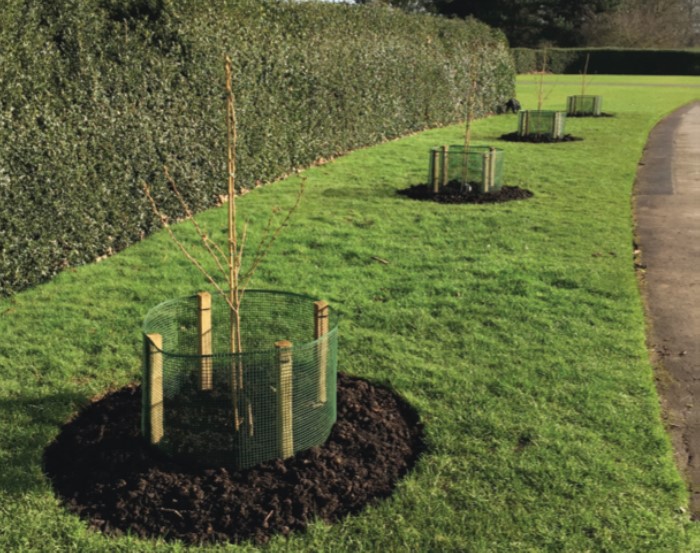
Sources and references
Trees & Design Action Group, (2014). Trees in Hard Landscapes; A Guide for Delivery.
A. Hirons & H. Sjoman, (2019). Tree Species Selection for Green Infrastructure: A Guide for Specifiers
Actions
- Provide tailored tree planting advice to different stakeholders (corporate, utility, community etc) on tree planting to include a list of ‘preferred' species, size, planting and maintenance requirements 04.
Relevant corporate policies
| Priority | Responsibility for action | For review |
|---|---|---|
| Medium | 1. Belfast City Council | TBC - Short to medium term project |
| Current Performance Level | Performance Indicators | |||
|---|---|---|---|---|
| Moderate | Low | Moderate | Good | Optimal |
| Trees selected and planted without consideration of site conditions. | Appropriate tree species are considered in site selection. | Municipality-wide guidelines in place for the improvement of planting site conditions and selection of suitable species. | All trees planted in sites with adequate soil quality and quantity, and with sufficient growing space and overall site conditions to achieve their genetic potential and thus provide maximum ecosystem services. | |
R10 Tree Protection Policy Development and Enforcement
City trees are sometimes viewed as irritating and costly, dropping leaves on lawns, causing blocked drains, and damaging foundations and pipes with their roots. They may also be considered hazardous especially if they are not managed. For these reasons and more, people may want to remove trees from public land or private properties.
However, healthy trees can and should be protected, primarily due to the many benefits they provide to society. Belfast seeks to protect trees where appropriate. Conservation areas (CA) and Tree Preservation Orders (TPO’s) (https://www.belfastcity.gov.uk/ Documents/Guide-to-protected-trees) are just one example of the councils duty to protect trees. Trees may also be protected as part of planning conditions associated with planning approval. Any unauthorised works to trees protected by a TPO, CA (or planning condition) are dealt with by planning enforcement officers when they deem it appropriate. Planning enforcement officers should also liaise with the tree officers, who can provide more detailed guidance and supporting information on tree protection in development.
To carry out works to a tree protected by a TPO, consent from BCC is needed through submitting a tree works application. To carry out works to a tree in a conservation area, a six-week notice of intention must be submitted to the BCC as per the NI Planning Act (Northern Ireland) 2011 – Chapter 3, section 127. BCC can then either accept the notice or make a TPO.
Policies and guidelines set out the framework for planning and development and these apply to all sectors (public, private, voluntary, etc). New policies and guidance are subject to community consultation and are published and promoted on council platforms to raise wider awareness. Copies of all council policies and guidelines can be found on the Belfast City Council website.’
All TPOs are outlined and available to view online by visiting the BCC website Local View Mapping System available online here: https://explore.belfastcity.gov.uk/connect/analyst/mobile/#/main?mapcfg=TPOs and CAs
Figure 18: Belfast’s interactive online TPO map
Actions
- Adoption and implementation of LDP tree policies and publications of additional planning guidance
- Ongoing review of existing Tree Preservation Orders.
Relevant corporate policies
| Priority | Responsibility for action | For review |
|---|---|---|
| Medium | 1. Belfast City Council | TBC - Medium to long term project |
| Current Performance Level | Performance Indicators | |||
|---|---|---|---|---|
| Good | Low | Moderate | Good | Optimal |
| No tree protection policy. | Policies in place to protect public trees and employ industry best management practices, but inconsistently enforced. | Policies and practices in place to protect public and private trees, generally enforced. | Integrated city-wide policies and practices to protect public and private trees, consistently enforced and supported by significant deterrents. | |
R11 Maintenance of Publicly Owned Trees
Intensively managed trees include street trees and solitary park trees, which require more care and attention due to the additional stresses and challenges of city life. In order to ensure the safety of public trees, routine maintenance must be carried out. This includes planned cyclical inspections and appropriate maintenance. Belfast does not currently hold a full inventory of its publicly owned trees, so this is the first step in ensuring that all trees are maintained. This can also help when recording maintenance schedules and works varied out.
The frequency of land use and target value are key drivers for inspection frequency, therefore an understanding of public land use may be a useful tool in establishing an inspection rota. This could help prioritise monitoring and management.
Monitoring trees could help prevent the spread of diseases, the likelihood of falling limbs, and resolve issues such as roots heaving pavements, or tree guards and stakes being left too long and causing extensive damage.
Examples of street tree maintenance and pruning
Actions
- Develop an overarching audit regime for Tree Risk Management.
- Implement training and standardisation of tree maintenance methods.
- Draft up SMART targets for tree maintenance including third party planting initiatives.
Relevant corporate policies
| Priority | Responsibility for action | For review |
|---|---|---|
| Low | 1-3. Belfast City Council | TBC - Medium term project |
| Current Performance Level | Performance Indicators | |||
|---|---|---|---|---|
| Good | Low | Moderate | Good | Optimal |
| No maintenance of publicly owned trees, or on a reactive basis only. | Publicly owned trees receive only periodic inspection and maintenance. | Publicly owned trees are inspected and proactively maintained on a cyclical basis. | All publicly owned, intensively managed trees are routinely and thoroughly maintained on ongoing basis according to a comprehensive management plan. | |
R12 Management of Publicly Owned Natural Areas
Extensively managed trees are trees in parks, woodlands and other natural areas which are often allowed to grow more naturally and freely than intensively managed trees. These areas still require management to provide a healthy and diverse green space. They are often used by the public and therefore risk management is a key consideration. The frequency of land use and target value are key drivers for inspection frequency, and any inspection rota should accommodate this to prioritise monitoring and management.
A substantial and highly-valued part of Belfast’s urban forest is found in these areas, and efforts should be made to develop and implement good practices, and work in close partnership with landowners, charities, and volunteers.
Currently around two thirds of these parks are already subject of 3 year management plans and work is ongoing with the woodland officers to bring these other natural areas into management or positive non intervention too. Monitoring and managing these areas could help prevent the spread of diseases, reduce the level of risk, and resolve other issues associated with ‘unmanaged’ areas.
Figure 19: Indicative map of main statutory designations in Belfast
Contains public sector information licensed under the Open Government Licence v3.0.
Contains OS data © Crown copyright and database right 2022.
© OpenStreetMap contributors
Actions
- Continue to map and identify public owned areas, and refine so that there is a consistent idea of what and where public green space is.
- Continue to develop the current system for recording trees in woodlands and groups, assign a management unit to each and develop an appropriate management overarching plan (significant areas may also have or require an individual plan).
Relevant corporate policies
| Priority | Responsibility for action | For review |
|---|---|---|
| Medium | 1. Belfast City Council | TBC - Medium term project |
| Current Performance Level | Performance Indicators | |||
|---|---|---|---|---|
| Moderate | Low | Moderate | Good | Optimal |
| No natural areas management plans or implementation in effect. | Only reactive management efforts to facilitate public use (e.g., hazard abatement, trail maintenance). | Management plan in place for each publicly owned natural area to facilitate appropriate public use. | Management plan for each publicly owned natural area focused on sustaining and, where possible, improving overall ecological integrity (i.e., structure and function) – while facilitating appropriate public use. |
|
R13 Tree Risk Management
Risk management is vital in an urban setting; the number of people interacting with trees on a daily basis increases the likelihood of incidents involving trees. Risks of trees include falling branches, toxic/poisonous leaves, berries seeds etc., pollen (inducing hay-fever), roots uplifting pavements (trip hazards) and pests (i.e. Oak processionary moth).
These risks must be assessed and a strategy implemented to minimise the risk to people. Naturally, one of the best ways to reduce risk is to avoid certain situations during species selection and planting. Avoid planting trees with toxic fruits in areas frequented by children and dog-walkers. Some pests can be eliminated before they become a problem using pesticides/fungicides and biological controls. Giving trees a reasonable amount of space and deep soil around the base to allow roots to spread comfortably will reduce the likelihood of upheaval.
Existing trees and new plantings should be monitored to spot these issues early and prevent any further risks developing. A system should be implemented to ensure that all trees have a routine assessment at regular intervals, and methods of risk reduction and management are well known and well executed. Zoning is a practice whereby landowners and managers define areas of land according to levels of use. This prioritises the most used areas, and contributes to a cost-effective approach to tree inspection, focusing resources where most needed. Inspection methods and frequency may vary depending on whether the management strategy is intensive or extensive.
Further detail on Tree risk management can be found in Appendix V.

Sources and references
National Tree Safety Group. (2011). Common sense risk management of trees. Forestry Commission
Actions
- BCC to move from a 5 year to 3 year inspection cycle.
- Subject to DFI approval, street tree surveys will move from a 5 year to a 2 year inspection cycle.
Relevant corporate policies
| Priority | Responsibility for action | For review |
|---|---|---|
| Low | 1-2. Belfast City Council and Department for Infrastructure | TBC - Medium term project |
| Current Performance Level | Performance Indicators | |||
|---|---|---|---|---|
| Optimal | Low | Moderate | Good | Optimal |
| No tree risk assessment or risk management program. Response is on a reactive basis only. | Level I (limited visual assessment) inspection and follow-up conducted periodically | Level II (basic assessment) conducted periodically, resulting in scheduled follow-ups. | Level II (basic assessment) conducted routinely, according to defined cycle and intensive follow-up (i.e., priorities and timelines for mitigation established based on the characterisation of risk). | |
R14 Biosecurity
Biosecurity refers to the need to prevent new pests and diseases being introduced into the UK from abroad. This measure is necessary to stop the spread of potentially devastating organisms and protect forestry, agriculture and horticulture. In recent history, the introduction of Dutch Elm Disease (Ophiostoma novo-ulmi) killed 20 million mature English elm trees between its introduction in the late 1960’s and 1980. By 1990, this figure had risen to 25 million, over 85 per cent of the British population. Now, Ash Dieback (Hymenoscyphus fraxineus) is sweeping through the country and will likely kill off 80 per cent of ash trees across the UK. In Belfast 11.3 per cent of trees would be vulnerable to Ash Dieback with an amenity value worth £242 million. Greater intra-diversity in Belfast’s tree population would make the urban forest more resilient to loosing such a valuable resource.
These diseases and others will continue to have a profound effect on trees and woodlands in NI. Native tree species provide vital habitat for many other species and without them there would be a huge ecological deficit.
The importation of trees, particularly large landscape trees, from across Europe and elsewhere can increase the risk of diseases being introduced to the UK. The Plant Health Regulation and Official Controls Regulation imposed by DAERA provides information and guidance in relation to management and reduction of impacts from pests and diseases within NI. Stringent importation rules are in place to attempt to mitigate this risk factor, and actions needed to protect plant health are set out in ‘The Plant Health (Official Controls and Miscellaneous Provisions) Regulations (Northern Ireland) 2020’. Found online here: https://www.legislation.gov.uk/nisr/2020/293/contents/made
Belfast must take responsibility for the sourcing of its trees, and actively work to eliminate pests and diseases from its urban forest and prevent new diseases becoming prolific.
Figure 20: Tree pest and disease introduction in the UK
Sources and references:
Brasier, C.M., 1996. New horizons in Dutch elm disease control;
Defra, 2014; Defra, 2018. A Green Future: Our 25 Year Plan to Improve the Environment;
The Woodland Trust: State of the UK’s Woods and Trees 2021.
Actions
- BCC will follow current Biosecurity best practice for the urban forest; and will continue to ensure that biosecurity measures are included in all tenders for supply of trees.
- Support local community tree nurseries and seed collection.
Relevant corporate policies
| Priority | Responsibility for action | For review |
|---|---|---|
| Medium | 1-3. Belfast City Council | TBC - Medium term project |
| Current Performance Level | Performance Indicators | |||
|---|---|---|---|---|
| Moderate | Low | Moderate | Good | Optimal |
| No biosecurity strategy nor actions in place for urban trees | Some consideration of biosecurity aspects, e.g., through pest management. | Biosecurity management actions are integrated in urban forestry. | Biosecurity strategy developed and implemented, with emphasis on urban trees. Integration of this into day-to-day urban forest management. | |
R15 Urban Wood and Green Waste Utilisation
Trees are a resource in many ways, from providing ecosystem services like carbon storage and pollution removal to bearing fruits and supporting wildlife. Often when a tree dies the branches are chipped and the bigger pieces are used for woodfuel or go to landfill.
However a tree’s value as a resource does not necessarily end when the tree dies or requires felling.
Although much of Belfast's green waste is used for composting there is potential to generate income through the by products of urban tree management.
Belfast will assess the potential of the arisings from the management of its urban forest for composting, district heating schemes, urban forest food and timber.
Figure 21: Uses of urban wood
Actions
- Commission a feasibility study on utilising Urban Wood and Green Waste.
Relevant corporate policies
| Priority | Responsibility for action | For review |
|---|---|---|
| Medium | 1. Belfast City Council | TBC - Medium term project |
| Current Performance Level | Performance Indicators | |||
|---|---|---|---|---|
| Moderate | Low | Moderate | Good | Optimal |
| No utilisation plan; wood and other green waste goes to landfill with little or no recycling and reuse. | While most green waste does not go to landfill, uses are limited to chips or mulch | The majority of green waste is reused or recycled – for energy, products, and other purposes beyond chips or mulch. | Comprehensive plan and processes in place to utilise all green waste one way or another, to the fullest extent possible. | |
R16 Native Vegetation
The urban forest is a diverse place, consisting of a range of trees and plants from all over the world. Whilst diversity is key to a healthy treescape, native plants should be considered and encouraged. Native species of trees, shrubs, fungi, ferns, insects, mammals, birds and more have evolved together in the UK, each finding and filling an ecological niche in which to thrive. The balance between species in an ecosystem is delicate, and just one missing link could tip the system out of balance.
Trees provide habitats for a whole range of species. In the UK, English oak (Quercus robur) supports more organisms than any other tree; more than 1,000 insect species have been identified to date on oaks in Central Europe, with at total of 2,300 different species relying on oak in the UK. Ash (Fraxinus excelsior) is frequently used as a nesting site for birds such as the redstart, nuthatch and owls, and the bark is important for certain lichen due to its pH. Without native trees, other native species may struggle to find suitable habitats and therefore suffer.
In Northern Ireland, areas of Ancient Semi-Natural Woodland (ASNW) are protected by the Forest Service. Unfortunately, these woodlands are now represented by very small fragmented remnants of woodland that once covered most of the country. Only three types of Semi Natural Woodland can be found today; upland oakwoods, upland mixed ashwoods, and wet woodlands. Though these environments are crucial to the overall wellbeing of NI’s natural capital, urban forests are very different environments from ancient woodlands, and therefore tree selection should be carefully considered.
Figure 22: Ancient trees around Belfast from the Woodland Trust Ancient Tree Inventory
Sources and references:
Purpose: Protect Oak Ecosystems, 2019. https://protectouroaks.wordpress.com/work-packages/wp4/purpose-impact-event/
https://herbaria.plants.ox.ac.uk/bol/ancientoaksofengland/distribution
The Woodland Trust. (2022) Ancient Tree Inventory - Tree Search Belfast. Available online: https://ati.woodlandtrust.org.uk/tree-search/?v=2086686&ml=map&z=13&nwLat=54.61186225896415&nwLng=-6.073785637817419&seLat=54.53902816504335&seLng=-5.779386376
34281
Actions
- Discuss appropriate quantifiable targets for native vegetation and review this with relevant officers.
Relevant corporate policies
| Priority | Responsibility for action | For review |
|---|---|---|
| High | 1. Belfast City Council | TBC - Medium term project |
| Performance level | Performance Indicators | |||
|---|---|---|---|---|
| Good | Low | Moderate | Good | Optimal |
| No co-ordinated focus on native vegetation | Voluntary use of native species on publicly and privately owned lands; invasive species are recognised. | Use of native species is encouraged on a project-appropriate basis in all areas; invasive species are recognised and discouraged on public and private lands. | Native species are widely used on a project-appropriate basis. | |
R17 Research and Development
Belfast’s comprehensive tree strategy is the first of its kind in Northern Ireland. This puts Belfast in a unique position to co-ordinate research into the management of its urban forest as a whole. Developing a working relationship with strong research institutions is an excellent way to further improve understanding of the urban forest and its management, not just in Belfast, but across Northern Ireland and the UK.
Research institutions such as the Nevin Economic Research Institute and universities may have access to additional funding, and be able to commit more time which could help Belfast to achieve the targets, priorities and actions set out in this action plan. They can support urban forestry in the city e.g., by engaging both researchers and students, offering the mutual benefit of developing Belfast's urban forest in a learning lab.
In addition to this, efforts should be made to identify relevant international research that can support Belfast's urban forestry program, for example by engaging in international networks like the International Society of Arboriculture, Tree Cities of the World, UN Green Cities network and the Biophilic Cities Network.
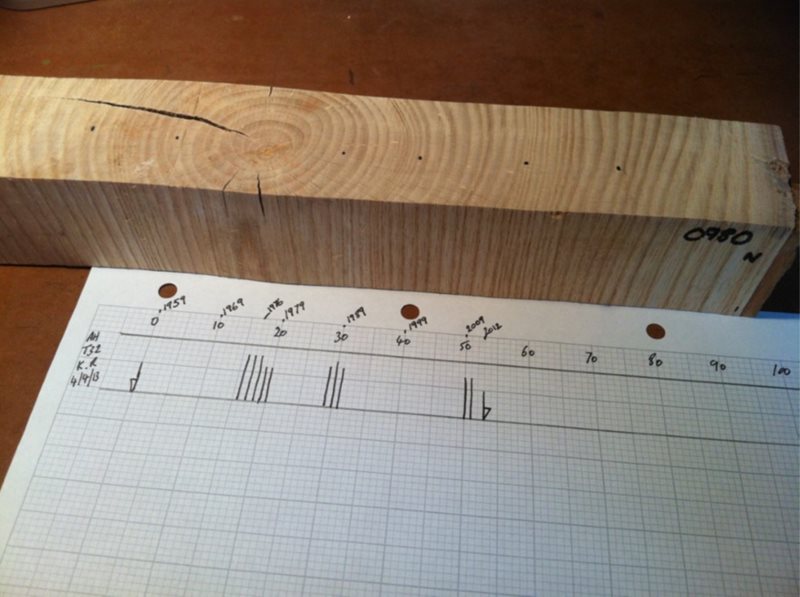
Actions
- Liaise with Universities, Forest Research and other agencies on potential joint research projects.
- Create a research agenda that will identify work packages that could go to University students and depts etc.
Relevant corporate policies
| Priority | Responsibility for action | For review |
|---|---|---|
| Medium | 1-2. Belfast City Council | TBC - Long term project |
| Current Performance Level | Performance Indicators | |||
|---|---|---|---|---|
| Moderate | Low | Moderate | Good | Optimal |
| No co-ordinated focus on research. | Some co-ordinated focus on research, and participation in / contracting R&D on a case-by-case basis. | Frequent co-ordination and assigning of research and development in support of urban forestry. | Belfast has a clearly defined agenda for research which it requires to help further its ambitions under the Tree Strategy. It is engaged with other leading institutions on research programs. | |
R18 Open Urban Forest Data and Web-map (Management and Assessment Tools)
Management and assessment tools are fundamental and indispensable when considering a resource as vast as the urban forest. Being able to clearly see tree data would help the urban forest management team keep track of the trees, and make the public aware of them and their value.
A Web-map is an interactive tool for displaying information to the public about the urban forest, and data can be broken down by ward. They can display a range of things including tree benefits such as canopy cover, annual ecosystem benefits (avoided runoff, carbon sequestration, air pollution removal), and tree condition, to name a few. They are an excellent way to engage with the public and communicate benefits of trees.
In creating a public web-map, tree data could be easily communicated and compared. Ideally the tool will be accessible, easy to use and comprehensive for the entire urban forest of Belfast. The data should be kept up to date with the most recent reviews of the urban forest.
Figure 23: A selection of online mapping tools.
Top right - TreeKeeper Canopy (https://canopy.treekeepersoftware.com/goshenin)
Top left - Hugsi (https://www.hugsi.green/city/?London)
Bottom Left - Torbay’s open access webmap (http://torbay.urbantreecover.org)
Bottom right - Treezilla (https://treezilla.org)
Actions
- Review current relevant webmaps in use in Belfast with a view to combining layers in a single open access site or commission a new bespoke webmap for the city.
Relevant corporate policies
| Priority | Responsibility for action | For review |
|---|---|---|
| High | 1. Belfast City Council | TBC - Short to medium term project |
| Current Performance Level | Performance Indicators | |||
|---|---|---|---|---|
| Low | Low | Moderate | Good | Optimal |
| No open source mapping resource is available to the public. | Information on some elements of the urban forest is available through a web map. | Large parts of the city's urban forest are presented through web maps. | Belfast has a clear and openly accessible tree management portal for all tree data. | |
Summary - Sustainable Resource Management Approach
| Key Performance Indicator | Current Performance Level (Low, Moderate, Good or Optimal) | Priority |
|---|---|---|
| R1 – Tree and woodlands inventory | Good | Low |
| R2 – Tree valuation and asset management approach | Good | Low |
| R3 – Canopy cover assessment and goals | Moderate | Medium |
| R4 – Tree equity | Moderate | Medium |
| R5 – Reviewing and improving the Tree Strategy | Moderate | Medium |
| R6 – Urban forestry funding | Good | Low |
| R7 – Urban forestry program capacity and staffing | Good | Low |
| R8 – Tree establishment planning and implementation | Moderate | Medium |
| R9 – Growing site suitability | Moderate | Medium |
| R10 – Tree protection policy development and enforcement | Good | Medium |
| R11 – Maintenance of publicly owned trees | Good | Low |
| R12 – Management of publicly owned natural areas | Moderate | Medium |
| R13 – Tree risk management | Optimal | Low |
| R14 – Biosecurity | Moderate | Medium |
| R15 – Urban wood and green waste utilisation | Moderate | Medium |
| R16 – Native vegetation | Good | High |
| R17 – Research and Development | Moderate | Medium |
| R18 – Open Urban Forest data and Web-map | Low | High |
Section 4 - Consultee Feedback
“The development of a physiology that made man possible was made possible by trees… that, is our debt”
J.S Collins
“Tree planting is important, but in the right place. Trees need to be valued and cared for. Education around urban and suburban trees needs to be prioritised.”
Belfast Resident and consultation respondent
Introduction and Background
As an integral part of this strategy, public consultation was sought, in order to gather opinions from a wide section of the community on how trees in Belfast are perceived and managed. The process was undertaken in 2 distinct phases. The first phase included an online public survey to gather opinions before any of the strategy was written, helping to inform its scope and direction, whilst the second phase was a series of workshops held in each district of the city after the draft had been presented. This was in order to gather feedback on the strategy and make a series of minor changes.
Phase 1 of the consultation, the public opinion survey, consisted of around 20 questions with quick, selectable answers and additional space for free text on each. Feedback was overwhelming, which saw one of the greatest responses Belfast City had seen in recent times, with 615 respondents taking part and 200 pages of comments.
A key result of the first phase highlighted the main themes that members of the public want the Council to focus on. These are:
- Environmental and climate change concerns
- Protecting Belfast’s Tree’s, woodlands, and hedges for future generations
- Producing a comprehensive tree strategy for the city and moving forward with its delivery
- Concerns regarding tree felling, tree management, health and safety, woodland, and hedgerow maintenance
- Tree provision and planting to ensure equality of distribution across the city
- Planning advice and concerns regarding trees
- Biodiversity and concerns for native species
Phase 2, the roadshow, took the completed tree strategy out to the communities in Belfast. City staff were on hand to demonstrate the strategy and request feedback on the draft document. Although it was a much more concise consultation with 5 questions - 119 respondents left their views with an extra 30 pages of comments.It was very encouraging to see the engagement relating to the creation of a tree strategy explored in Phase 1, becoming overwhelming support for the content of this document in Phase 2.:
Response to phase 1
Q1: Tell us about yourself (select one option), I am responding as:
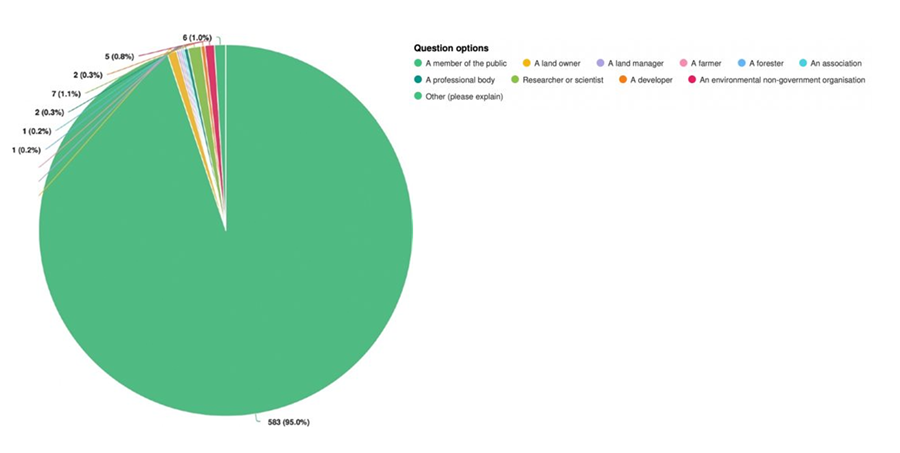
Q2: In which area of Belfast do you live ? (District Electoral Area)
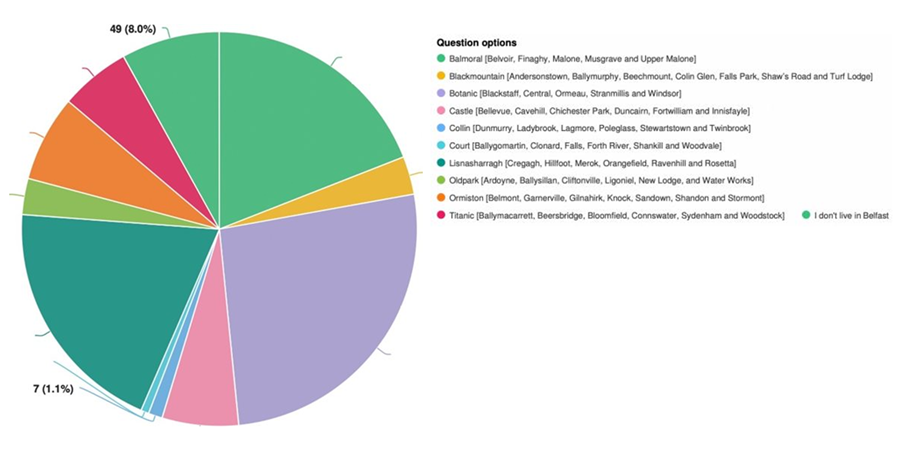
Q3: Thinking abut Belfast today, do you think there are too many, too few or about the right amount of trees across Belfast?
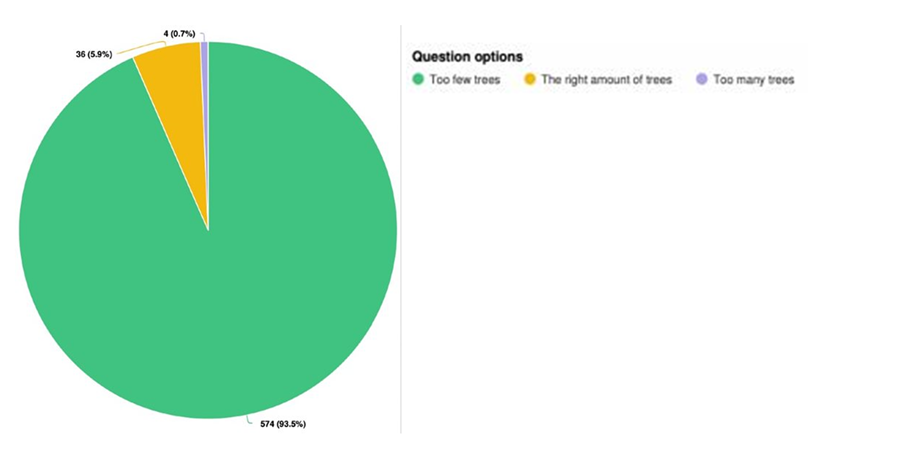
When asked about the amount of trees across the city region the overwhelming response is that Belfast has too few trees.
With nearly complete consensus on this matter, this question highlights the need for the strategy being developed here to increase the numbers of healthy trees in the city.
This strategy includes a target of more than doubling canopy cover to 30 per cent which will go a long way to addressing this challenge.
Q4: Thinking specifically about your neighbourhood, do you think there are too many, too few or about the right amount of trees in your neighbourhood?
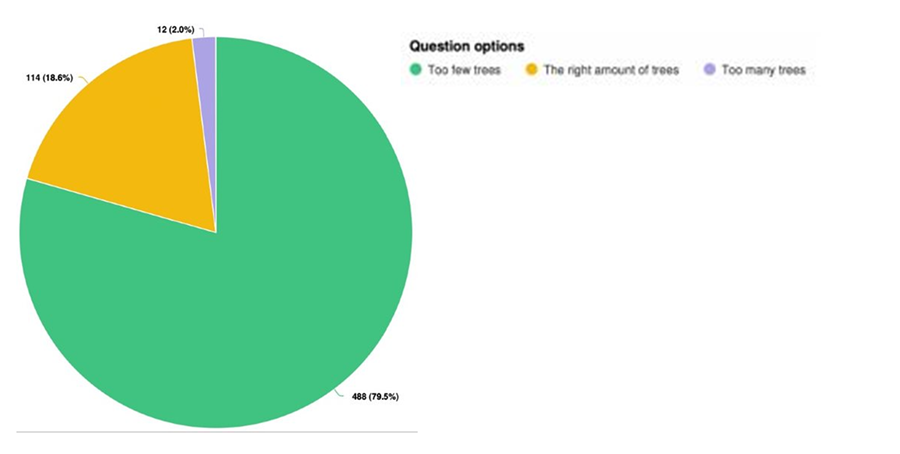
When asked specifically about the amount of trees in the respondents own neighbourhood, again the response indicates the desire for an increase in tree population.
Alongside the directed advice on tree planting efforts in this strategy there is also focus on local woodlands and natural areas. At a neighbourhood level a concerted effort to monitor and manage these areas can lead to an increase in quality of these spaces.
Q6: Can you see any trees from your property?
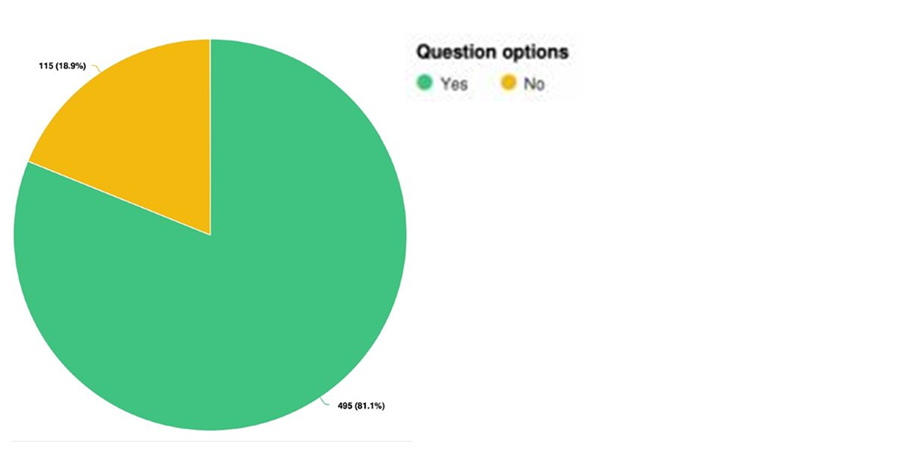
The majority of survey respondents (81.1 per cent) state that they can indeed see trees from their property.
This does not necessarily mean that there is an abundance of trees or that these trees are in good health. It does however show that despite being in relatively close proximity to trees, the consultees have a desire to see a more developed urban forest landscape throughout their city and not just around their own properties.
Q8: How do you feel about these trees?
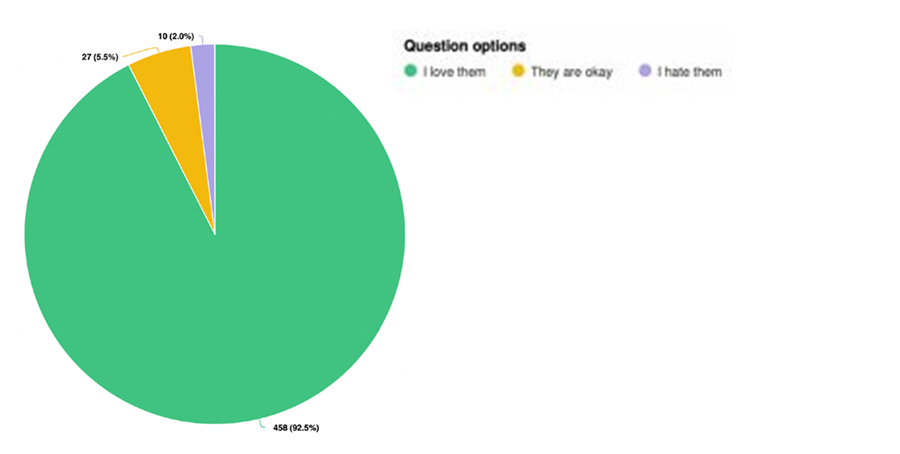
The responses to question 8, regarding the feelings towards the trees that consultees can see from their properties are exceptionally positive. The few which are negative are understandable and the comments of the respondents reflect the main themes of a lack of light, excess leaf litter and lack of maintenance.
The positive feedback reflects consultees intrinsic understanding of the value of urban trees, even if they are not directly aware of the specifics. The strategy recommends periodic monitoring of the benefits of the urban forest. As the urban forest grows, these benefits should increase with a larger, healthier and more diverse urban forest treescape.
Q10: Do you have trees on your own property or on a shared space?
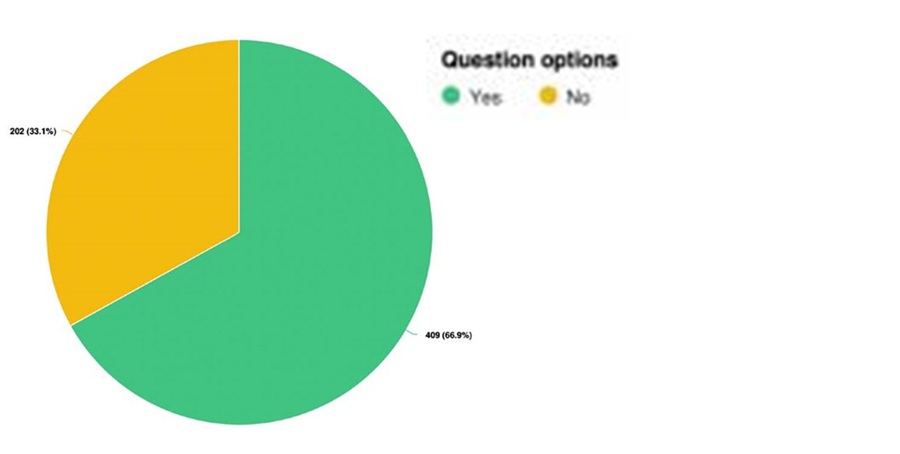
When asked about the trees in the respondents property or shared space, there is a majority who have direct access to trees.
These trees are much more difficult to record and monitor accurately, however due to the number of private gardens and other privately owned trees these make up a significant proportion of the tree population.
The tree strategy emphasises the importance of monitoring trees on private property with a view to enhancing decision-making around the urban forest.
Q11: Would you like to have trees on your own property or on a shared space?
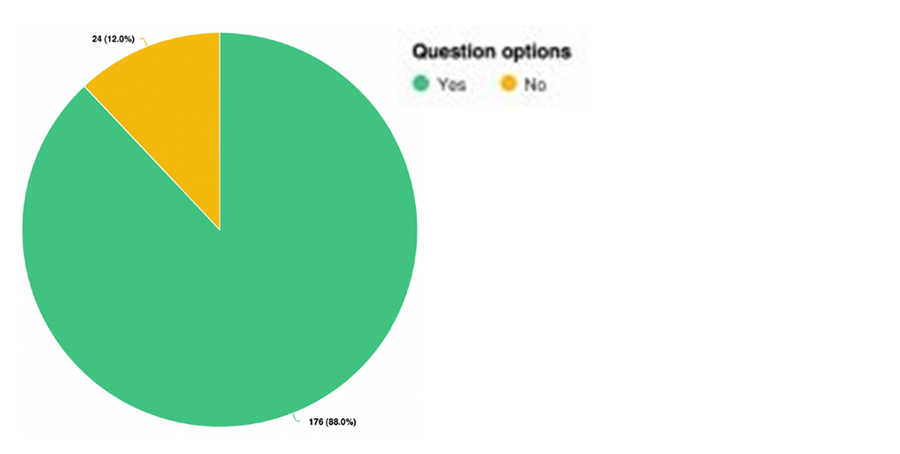
Question 11 shows yet another clear desire for trees to remain and play an enhanced role in the urban fabric.
This strategy is clear that site suitability and risk management should always be taken into account when planting new trees, however it also emphasises the possibility of both environmental and social benefits when involving a community in a tree planting project. Shared spaces and private land can be prime examples of where the residents take on projects that increase the strength of the urban forest for all the residents in the area.
Q14: Do you think Belfast would benefit from having a dedicated Tree Strategy in place?
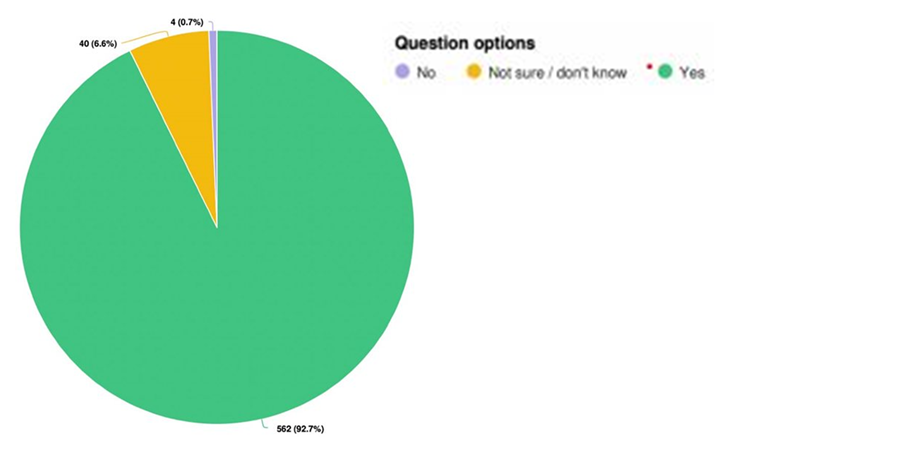
When considering all the previous responses shown in this section it becomes very clear that the consultees, which were primarily members of the public and residents of Belfast, support the development of the urban forest.
The majority believe that there should be more trees in their neighbourhood and city wide. Many can see trees from their property or have trees on their property. With an increase in tree cover comes an inevitable need for maintenance and concerns about their impact, yet the overwhelming majority still want to have trees in these spaces and enjoy their presence.
There is also general recognition in the need for a strategy and a desire for increased maintenance and management of the urban forest, increasing the tree population, maintaining its health and increasing its connection with the community.
Belfast City Council sincerely thanks the many respondents who took the time to do the survey and provide extensive feedback and insight about Belfast's trees and what they mean, not just to Belfast’s residents, but also its visitors and wildlife.
Consultee Feedback - Phase 2
Responses to Phase 2
Q1: Tell us about yourself (select one option), I am responding as:
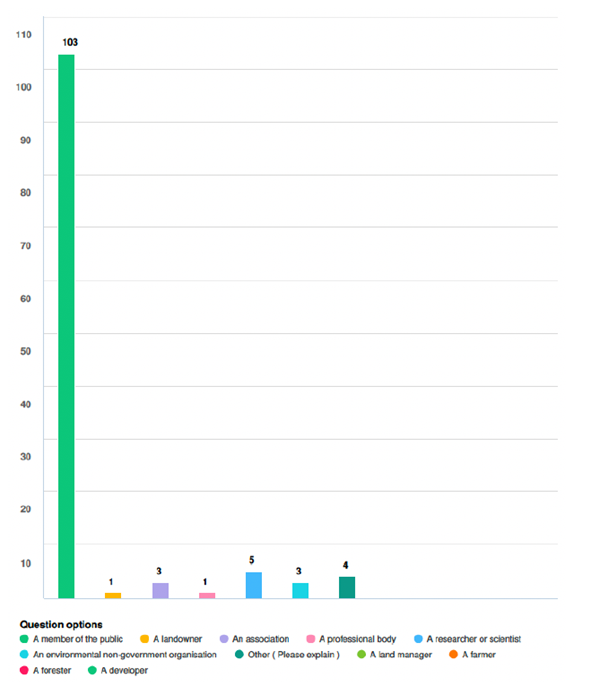
Q2: In which area of Belfast do you live ? (District Electoral Area)
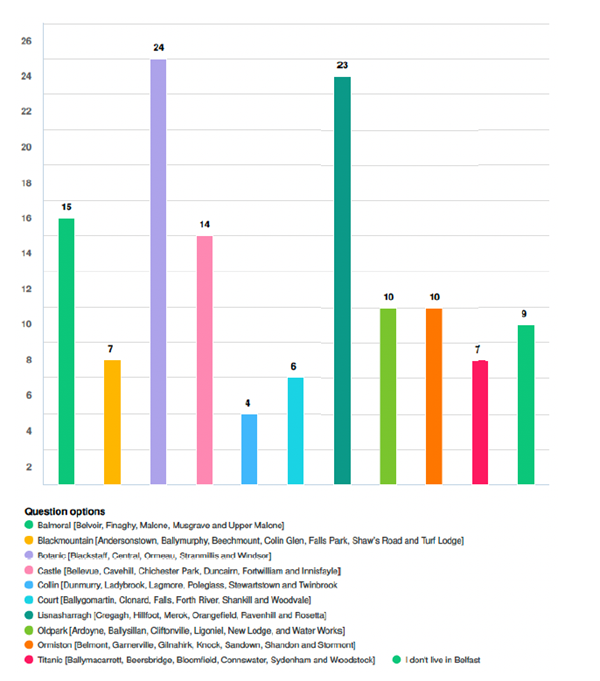
Respondents in Phase 2 were still predominantly members of the public (86.6 per cent) similar to the results from Phase 1. Botanic, Lisnasharragh and Balmoral had the highest proportion of respondents in both phases of the consultation. By and large respondents were equally distributed across Belfast. This is very encouraging as no one area was overly dominant in the process. Therefore the consultation took in views from Belfast's leafiest areas and those with least exposure to the urban forest.
Consultee Feedback - Phase 2
Q3: The Belfast tree Strategy’s is that “That Belfast is a city which focuses on protecting, enhancing and expanding its woodlands, hedges, and trees, connecting people to nature,and ensuring that these continue to be a major asset to everyone who lives, works, and visits our city.”
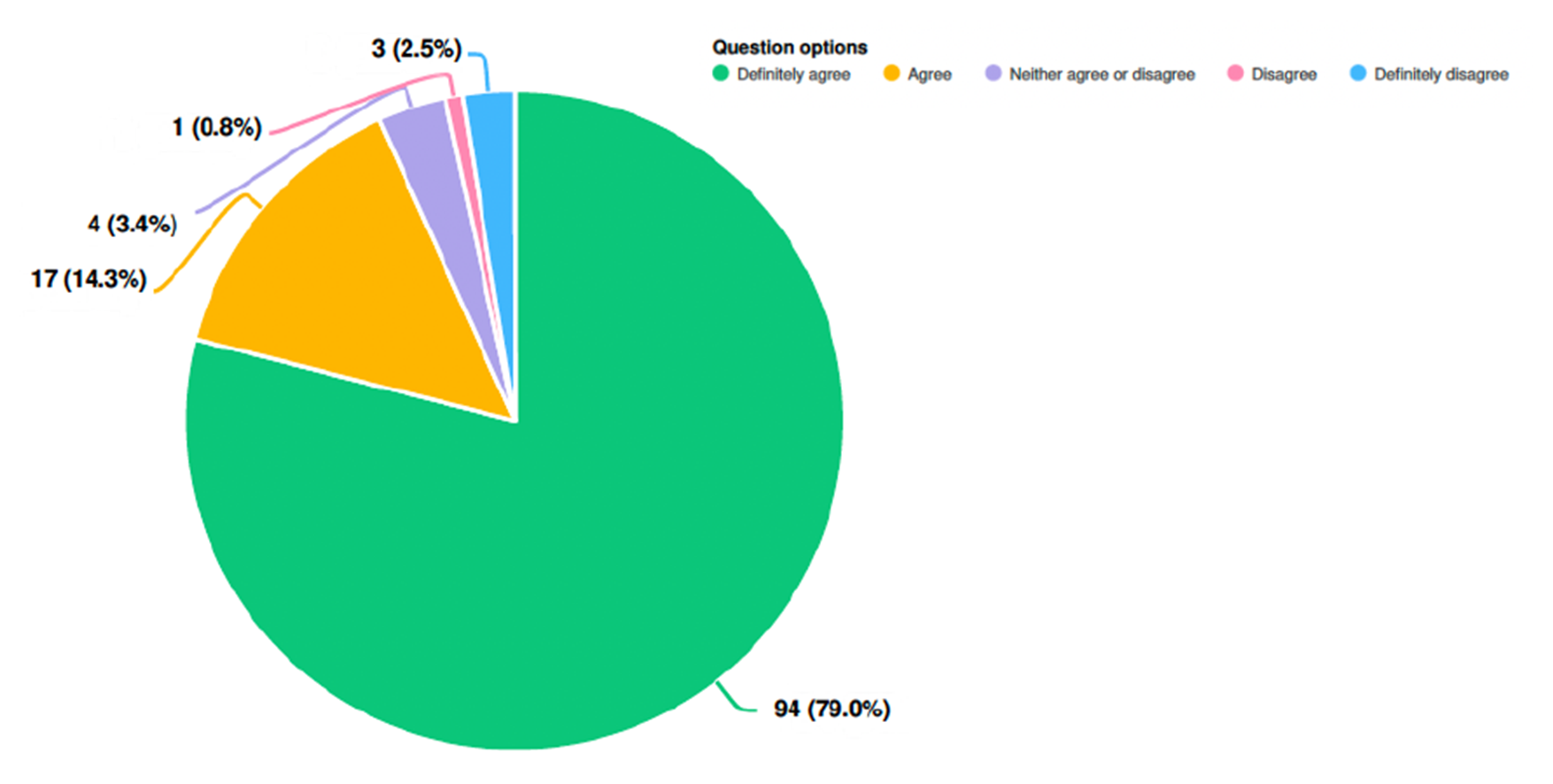.png?width=900&height=454)
Q4: The Draft Tree Strategy sets out Targets, Priorities and Action on Trees and Urban Forest Structure, Community Framework and Sustainable Resource Management. To what extent do you agree or disagree with our proposed targets, priorities and actions?
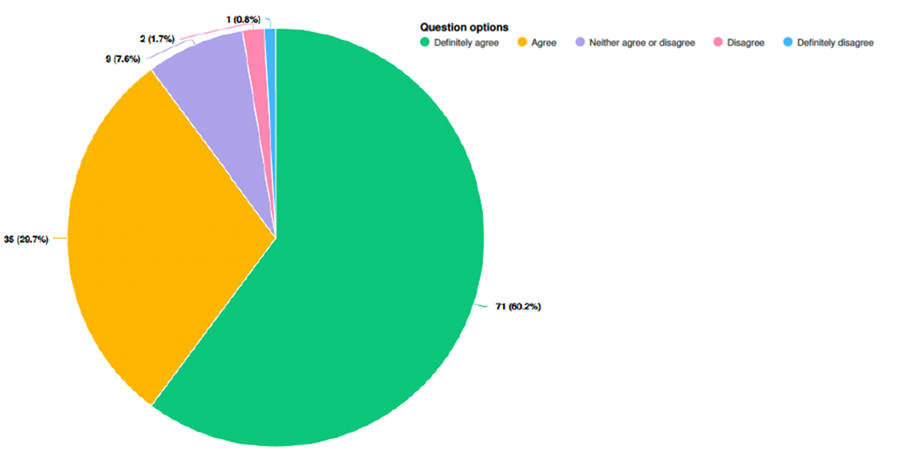
Q5: The Council sets out 23 commitments through its Draft Tree Strategy. To what extent do you agree or disagree with these commitments?
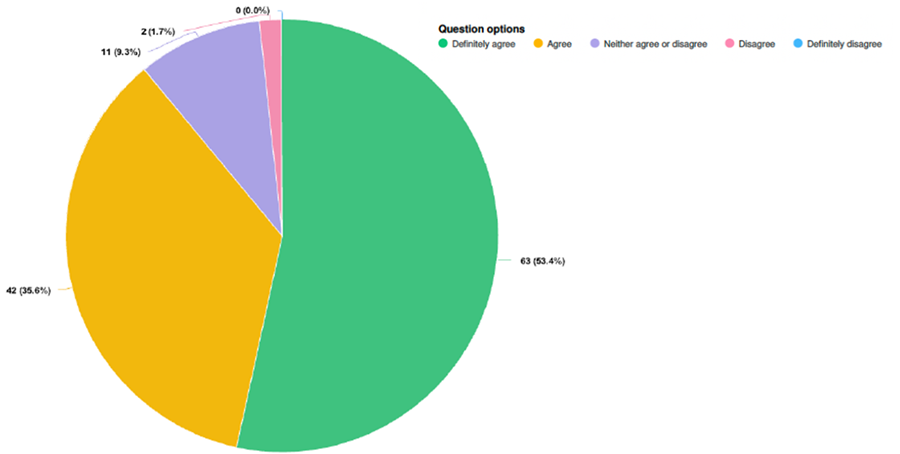
The initial need for a tree strategy was demonstrated in Phase 1 with 92 per cent of respondents supporting the creation of a dedicated tree strategy for Belfast. It is very encouraging to see the continued support for this, in response to the publication of the draft strategy. The feedback was over 90 per cent positive for both the “Vision” and the “Targets, Priorities and Actions”. Belfast City Council is acknowledging and acting on this overwhelming desire for action whilst also embracing the need for a strategic approach to urban forest management.
Section 5 Technical Appendices
Technical Appendices:
Preamble
These policies are intended as guidelines for determining whether requests for the pruning or felling of Belfast City Council directly managed trees should lead to action.
It is not possible to anticipate every situation and it is therefore important that whilst these policies guide decisions they should not be considered prescriptive. Furthermore, no one policy should be considered in isolation, but all relevant policies should be considered when reaching a decision.
As trees are individual living biological structures each case will be taken on its own merit and these policies should further be considered in the context of wider strategic aims relating to individual areas, local management plans and the Councils new Tree Strategy.
As a general guideline, trees will not be removed or be subjected to inappropriate Arboricultural management simply for the requirements of their biological function, see the information contained in the section “Benefits of Trees” in the main strategy.
Safety
Where there is a clear and foreseeable threat to the personal safety of residents or visitors, or to property, that is directly related to the condition of a tree, action will be taken to control that risk.
The Council is currently developing its Tree Risk Management Strategy a summary of which is at appendix V, and all decisions will be taken in accordance with the policies and priorities laid out there.
Risk that is an indirect consequence of a tree (e.g., slippery leaves on the pavement in autumn) will be dealt with through pruning only in unusual circumstances where other options are not available.
Unfounded or perceived fear of a tree or trees will not normally result in action to prune or remove the tree, eg “the tree is too tall”.
Financial Constraints
Belfast City Council unfortunately does not have unlimited resources with which to manage its tree stock. The resource it does have has to be used holistically in keeping with its management policies and in some cases work simply cannot be justified on the grounds of priority.
5.1 Appendix I: Council Owned Trees
Technical Appendix I: Council Owned Trees
1.1 Which Trees are the Council's
This part of the strategy sets out the Council’s approach to the management of trees for which it is directly responsible. This work is largely confined to the urban areas of the city.
Tree management encompasses the co-ordination of all maintenance operations to existing trees as well as new tree planting. The existing tree population is a valuable resource, which requires more than just maintenance if it is to continue to provide the range of benefits that we expect. Management must include a long-term view of the tree resource, providing for the future as well as for today.
There are five major elements of the city's tree population:
- Street trees - These are the trees planted in pavements or road verges along the streets. They help to filter air pollution, provide shade for car parking, calm traffic and improve the overall appearance of the street scene. Belfast City Council manage and maintain the street tree population for and on behalf of the Department for Infrastructure who are the “owners” of these trees.
- Woodlands and countryside - Belfast City Council owns or manages a number of sites of ancient semi-natural woodland and other areas of importance to the natural environment. The rarity of this type of woodland and the mosaic it creates makes its preservation very important.
- Trees in parks and open spaces - These are commonly the most significant trees in the area and have a profound effect on its appearance and, consequently, upon the leisure experience of users of the open space as well as for visual amenity for Belfast City Council’s residents and visitors alike.
- Housing area trees - These are the trees found in and around housing estates. The trees were often in residential areas to enhance the local environment and landscape. Trees growing within housing estates are owned by and the responsibility of the Northern Ireland Housing Executive.
- Plantations - These are significant to the area. These are mostly made up of recent plantings undertaken as part of the the Belfast Million Tree Initiative will greatly increase the number of plantations and all these plantations are a very valuable resource in terms of visual amenity and as a habitat for wildlife and require considerable management input if they are to mature into the woodlands they were intended to be and this is dealt with in more detail in Appendix IV.
5.2 Appendix II: Management Standards for Council Owned Trees
Technical Appendix II: Management Standards for Council Owned Trees
2.1 Carriageway Obstruction Due to Trees
The Council will seek to work with DfI who will ensure that adequate clearance of the highway for the type of traffic using that highway is maintained at all times.
This links to DfI Road Order (RO); Article (Art) 48 - Removal of fallen structures, trees etc., Art 88 - Obstruction of roads.
2.2 Drains
Trees do not have the capacity to break into a sound drain, but they will exploit any existing fault. The removal of one tree will not prevent other vegetation from exploiting the same opportunity and clearly will not fix a broken drain. Action may be considered by the Council to secure the repair of any leaking foul water drain in order to protect the groundwater from pollution.
The Council’s presumption is that the appropriate way to deal with tree root blockage of drains is to ensure that the drains are watertight. Accordingly, the Council will not normally take action in response to complaints that Council managed trees are blocking drains.
In terms of street trees this links to DfI RO: Art 45.Drainage of roads, Art 46.Obstruction of, interference with, or discharge of material into, a road drain, etc., Art 47.Filling in of roadside ditches, Art 53.Prevention of water falling or flowing on to roads.
2.3 Honeydew
As with leaves, honeydew is not readily controllable by pruning and cleaning of affected surfaces can be considered to be routine maintenance. Pruning will not normally be considered solely as a way of alleviating problems with honeydew.
This links to DfI RO; Art 59 Removal of nuisances.
2.4 Leaves, Seeds, Fruit, Nuts & Berries
Leaves and seeds are carried freely on the wind and are largely outside the control of Belfast City Council. Clearing of leaves from gutters and pathways and weeding of set seeds are considered to be normal routine seasonal maintenance which property owners are expected to carry out.
Pruning will not normally be undertaken to attempt to reduce the fall of leaves, seeds or fruit.
2.5 Parks and Open Spaces
The City has nearly 50 major parks, including:
- Alderman Tommy Patton Memorial Park
- Alexandra Park
- Barnett Demesne
- Belfast Castle Estate
- Belfast City Hall Grounds
- Belmont Park
- Botanic Gardens
- Bridges Urban Sports Park
- Carnanmore Park
- Carr’s Glen Linear Park
- Cave Hill Country Park
- Clarawood Millennium Park
- Clement Wilson Park
- Dover Street Millennium Park
- Dr Pitt Memorial Park
- Drumglass Park
- Dunmurry Park
- Dunville Park
- Falls Park
- Finlay Park
- Forthriver Park
- Gasworks
- Gilnahirk Park
- Glenbank Park
- Glencairn Park
- Greenville Park
- Grove Playing Fields
- Grovelands
- Jubilee Park
- King William Park
- Knocknagoney Linear Park
- Lagan Meadows
- Lenadoon Millennium Park
- Ligoniel Park
- Loughside Park
- Marrowbone Millennium Park
- Michelle Baird Memorial Park
- Musgrave Park
- Northwood Linear Park
- Orangefield Park
- Ormeau Park
- Sir Thomas and Lady Dixon Park
- Springfield Dam
- Springhill Millennium Park
- Tullycarnet Park
- Victoria Park
- Waterworks
- Wedderburn Park
- Woodvale Park
Trees and hedges are fundamental to the structure of parks and green spaces. The trees in parks and open spaces are not only important to regular visitors; they are very important contributors to the overall environment of the area. They are a high value resource that requires active management if they are to prosper and bestow the benefits we would hope for.
The nature of tree populations of different parks and green spaces is as variable as the character of the sites themselves. At one extreme there are the older parks, such as Ormeau, with a declining, mature population of trees including a number of rare and interesting specimens. At the other extreme are the newer Urban Parks and Open Spaces, such as Clarawood, Lenadoon and Marrowbone Millennium Parks, with a developing tree population. For this reason the management of park and Greenspace trees has to be planned on a site-by-site basis, seeking a balanced tree population and a character for each.
Some of the newer parts of the Belfast City Council area contain large open spaces with a very high proportion of short grass, some structure planting and little else, such areas are ripe for enhancement. Creating small, wooded areas in low habitat value areas can create opportunities for wildlife whilst improving the landscape and creating a place of real value for local residents.
2.6 Traffic signal / street sign obstruction
The Council will endeavour to ensure that trees under their management do not obscure road signs or prevent streetlamps from illuminating the highway.
The purpose of streetlamps is to illuminate the public highway and where adequate illumination of the highway is present the Council will not normally take action to improve the levels of illumination of private property.
This links to DfI RO; Art 8 Duty to Maintain, Art 49 Prevention of obstruction to view, etc., Art 50 Removal of potentially dangerous trees and hedges.
2.7 Tree and TV / Satellite Reception
There is no right to good reception and in many cases, it is possible to resolve issues of poor reception involving trees by finding an engineering solution. Belfast City Council will only consider requests to prune trees to improve reception where all the following conditions are true:
- Efforts have been made to find an engineering solution to the problem and have not been successful.
- The work required is consistent with good Arboricultural practice and will not unduly affect the amenity or health of the tree.
- The work required can be executed within current financial constraints.
This links to DfI RO; Art 8 Duty to Maintain
2.9 View and Right to Light
Action will normally only be considered where the separation between the tree and the window of the nearest habitable room is less than 6m for trees with a height of over 12m, or less than half the height of the tree for smaller trees, or where the separation between the edge of the canopy and a vertical line through that window is less than 2m.
A ‘habitable room’ means a dining room, lounge, kitchen, study or bedroom but specifically excludes WCs, bathrooms, utility rooms, landings and hallways.
Where a situation falls within these guidelines’ cases will be prioritised according to proximity and account will also be taken of the orientation of the affected window. The results of any consultation exercise may modify decisions if it appears that any work would be by and large unpopular with the rest of the community.
2.10 Wild Animal / Insect Pest
As with leaves and honeydew, the actions of the trees associated wildlife, such as birds, squirrels and insects etc. is considered to be beyond the reasonable control of the Council. Pruning or other works will not normally be considered as a means of controlling such nuisance.
5.3 Appendix III: Plantations, Shelterbelts & Woodlands
Technical Appendix III: Plantations, Shelterbelts & Woodlands
3.1 Plantations and Shelterbelts
Plantations are those groups of recently planted trees, where the intention is to allow them to develop into copse or woodland stands. Often the trees will have been close planted with little or no understorey or edge planting and virtually never any herb layer. Often these plantations are done via a Woodland Grant Scheme or other similar grant aid vehicles. More often these plantations occur in local parks, on open spaces, in countryside areas and Local Nature Reserves where it is relatively easy to establish large areas of closely planted trees with the minimum of consultation and planning.
In order that these plantations can “evolve” into species rich woodland that will be a value to the community they will need substantial additional work, i.e. thinning, additional planting of shrubs, edge planting, addition of herbs and often the introduction of deadwood to speed up the ecological processes. All this has a cost and manpower implication for the owner, whether that be the Council or a private third party and this should be considered in full at the time of planning any new project.
Shelterbelt plantings take the form of strips of trees and shrubs planted for visual screening or windbreak purposes. Such shelterbelts often occur within the area as planting strips on land alongside the newer “parkway” style road systems (e.g. Motorways, trunk roads and the like) and the adjacent developments, which have been planted with a mix of naturalised and native tree and shrub species to provide ‘parkland’ like settings. Parkways can be described as highways with relatively wide grass verges or landscape strips adjacent to the carriageway and occasionally as a central reservation. An example of parkway style roads are the M1 or the A2.
Where the shelterbelts are maturing and are performing their designed function of screening and sheltering extremely well then the broad principles are those of woodland management, e.g. thinning, coppicing and selective felling. While management has taken place on many of these sites it has not been carried out strategically. Management must be carried out on a rotational basis to ensure that seriously neglected areas do not occur. Areas that become neglected are difficult to manage in a sensitive or cost-effective manner.
These plantations and shelterbelts provide important wildlife corridors and habitats throughout the Belfast area and link open spaces with blocks of woodland and the rural areas. The Council will ensure that any revision of the management plan for plantations and shelterbelts will include the principles of wildlife protection.
3.2 Veteran Trees – Ancients and Pollards
Belfast has few old trees and the areas of remaining parkland and old trees in the area are important. Old, veteran and ancient trees are very important links to historic landscapes and are known to support highly diverse communities of invertebrates and lichens. Areas of the Belfast City Council area are pasture woodland, dating from medieval times. New trees can be established but will not have any great interest for many, possibly, hundreds of years.
Information on the old trees in the area is limited and needs to be increased. It is likely that the number of these trees has declined through neglect in appropriate management or removal. Pollarding is essential in extending the lifespan of old pollards, which may disintegrate without active pollarding. Old trees are prone to damage through changes in land use, particularly, conversion of surrounding grassland to arable. In addition their wildlife value is reduced by the removal of dead wood from within the crown or fallen branches.
3.3 Woodlands
It is evident that Belfast City still contains a significant number of woodlands. This section deals with woodlands, both those in Council control and those in private ownership.There are fragments of ancient and long-established woodlands within the City including Belvoir Forest Park, Ormeau Park and Throne Wood. These and other sites can be viewed on the Woodland Trust’s Ancient Woodland Inventory.
Ancient woodland is defined as land that from archive evidence alone would appear to have been continuously wooded since 1600. Long-established woodland is defined as land that from map evidence would appear to have been continuously wooded since the first edition OS maps of 1830-44, but for which no positive evidence of antiquity has been found in older documentation.
There are several woodlands in the Council’s ownership that have not been identified in the Inventory but are nonetheless remnants of ancient semi-natural woodlands
The Council’s management objectives are landscape, nature conservation and recreation. Other objectives such as timber production are very limited but should be pursued where appropriate and do not conflict with the primary objectives. Where deemed appropriate the Council uses Tree Preservation Orders to help ensure no inappropriate works are carried out to woodlands.
The composition of the typical ancient woodland of the eastern side of the Belfast area is Oak and Birch, National Vegetation Classification (NVC) W10 or W16 dependent upon geographical location and soil type. The remaining area of the city is predominantly W8, which is an Oak Ash mix.
The traditional and most common form of management of woodlands in the area was the system known as coppice with standards. This involves periodic cutting back of the woodland understorey (coppicing) to produce smallwood material for hurdle fencing, thatching spars etc.; larger trees (standards) were retained at wide spacing and were grown on to produce timber for a variety of uses. This historic form of management has produced woodlands of tremendous value for nature conservation with a wide number of species being supported in the variety of microhabitats created. Such management ceased early this century and many woods have since become neglected and have reverted to high forest.
Many of the woods in the Belfast area are now managed with nature conservation objectives as a priority. Those managed by wildlife groups, such as TCV, Belfast Wildlife Trust, the Forestry Commission or the Belfast Hills Partnership have started to re-introduce coppicing as a form of management where appropriate. The future management of woodlands must address the problems of neglect, which have afflicted many woodlands nationally over the past 75 years or more. It must also take into account the multi-purpose objectives, which woodlands today must fulfil. Some traditional management is carried out by conservation volunteers on a number of sites in order, primarily, to retain the conservation value of the wood. This work helps to keep the basic skills in use and also acts as an example to other woodland owners interested in bringing their woods back into management, which benefits wildlife.
Nationally, as well as locally, traditional woodland management has declined since the First World War, mainly due to increasing labour costs, overseas supplies and the introduction of plastics and other materials. The loss of market for traditional woodland products has resulted in little or no management works being carried out. This has left woods neglected; the wildlife habitats that depend on the management system suffer, as does the age structure of the wood making it a vulnerable landscape feature.
Commercial coppice management is very rare in the Belfast area, although there has been something or a resurgence of interest in coppice products (for example, hurdle fencing, weaving, hedging materials and thatching spars), however, the market is underdeveloped and in some instances under supplied, probably due to a lack of coppice managed in rotation. Neglected coppice can take up to three years to produce useful material following post neglect cutting.
Woods give the Council opportunities to display best practice of management in pursuit of a number of objectives. The Council’s management objectives are landscape, nature conservation and recreational access. Other objectives such as timber production are limited and are usually only pursued when the other criteria are met.
Many of the woods in the area are of significant interest both locally and nationally. As such some have been identified as Areas of Special Scientific Interest (ASSI), Areas of Outstanding natural Beauty (AONB) Local Nature Reserves (LNR) or Sites of Importance to Nature Conservation (SINC). This indicates that some form of protection already exists on many woodlands, i.e. prior to carrying out management operations on a CSAC or SSSI the consent of the Council is required if they do not already manage the site.
The remaining areas of woodland are secondary woods generally having been planted since the first edition of the Ordnance Survey maps in 1876. These woodlands can have high landscape value and provide new habitat and useful links between existing sites. Most of these woods are in private ownership and not accessible to the general public. Main reasons for planting include timber production, recreation (sporting), amenity and wildlife habitats.
3.4 Hedgerows
Hedgerows are given three broad definitions. Those that fall under the Hedgerow Regulations those that are on private domestic property and those managed and maintained by the City Council.
The Hedgerow Regulations 1997 came in to force in March 1997. They protect “important hedges” from removal. Important hedges are defined in the regulations. The regulations apply to any hedgerow growing in, or adjacent to, any common land, protected land (local nature reserves and SSSI’s), or land used for agriculture, forestry or the breeding or keeping of horses, ponies or donkeys, if it:
(a) has a continuous length of, or exceeding 20 metres; or
(b) it has a continuous length of less than 20 metres and, at each end, meets another hedgerow. The regulations do not apply to hedgerows within the curtilage of, or marking a boundary of the curtilage of, a dwelling house.
If natural light is being blocked by the growth of a hedge then action may be taken to reduce the problem under the High Hedges Act, Northern Ireland 2011.The Council does not provide a mediation service so you should try to resolve a dispute between yourself and your neighbour amicably or seek advice from a solicitor or Citizens Advice.
The hedgerows under the council’s management remit will be maintained in accordance with good horticultural practice in keeping with the landscape function the hedge supports.
The management and the timing of operations to maintain any hedges will adhere to the requirements and restrictions of the Wildlife & Countryside Act 1981 (as amended).
5.4 Appendix IV: Hazards and Safety
Technical Appendix IV: Hazards and Safety
The Council has a statutory duty of care under the Health and Safety at Work Act 1974 and the Occupiers Liability Act 1999 to ensure that members of the public and staff are not to be put at risk because of any failure by the Council to take all reasonable precautions to ensure their safety.
A Risk Assessment is required under the Management of Health and Safety Regulations 1999. There is a need to inspect trees in, on or near public places, or adjacent to buildings or working areas to assess whether they represent a risk to life or property, and to take remedial action as appropriate.
This document sets out minimum standards of inspection, competence and record keeping that the council will commit to and is in accordance with the industry guideline document The Tree Risk Management Manual.
4.1 Hazard and Risk
In order to arrive at a reasoned Risk Assessment for Belfast’s Urban Forest the two separate factors of Hazard and Risk must be addressed.
Hazard is the potential to cause harm.
Like all living organisms, trees are subject to decline, senescence and collapse and they can be damaged physically or invaded by pathogenic organisms. As trees deteriorate so they are increasingly likely to shed limbs or fail in strong winds and the potential to cause harm increases.
Ancient and decaying trees are often beautiful and uniquely valuable as habitat for wildlife and, however poor the physical condition of a tree, remedial action is only necessary where there is a clearly quantifiable risk to life or property. This might mean removing part of the tree, the whole tree, or reducing the level of public access in the vicinity.
Risk is the level of likelihood that a hazardous tree will cause actual damage.
Risk is related to the location of the tree. It reflects the intensity of use of the immediate surroundings of the tree and the proximity of the tree to people, buildings or other structures (targets).
4.2 Safety Inspections (Trees)
It is the responsibility of the Council to ensure that tree inspection procedures are in place and that they are undertaken only by staff or others who meet the requirements of competence set out in section 5.5.
The tree inspection programme has four stages;
- an assessment of hazard;
- an assessment of risk;
- a prescription for remedial action;
- a plan for the recording and the re-inspection process.
These actions need not all be undertaken by the same person.
This links to Health and Safety Executive: Management of the risk from falling trees and branches SIM 01/2007/05.
4.3 Record of Inspections
All trees within red and amber zones will have the inspection recorded in an appropriately accessible electronic tree management package. Trees in green areas may be grouped and/or receive a lower level of inspection at the discretion of the Councils Principal Arborist.
Records must be retained for these inspections in perpetuity.
4.4 Determining Remedial Action
The appropriate remedial action must be prescribed by a competent person.
A record of action proposed and action taken must be maintained within the tree risk database.
The priority for implementing remedial action will depend on both the assessment of risk and hazard and related to the subsequent risk score.
In a high-risk area trees which show obvious signs of imminent collapse or are otherwise seriously hazardous should be dealt with immediately on the best advice of the inspector.
Provision must be made in departmental budgets for the implementation of tree inspection programmes and necessary remedial action on an annual basis as revenue expenditure.
4.5 Competence
The rating of target area’s (zoning) must be done in accordance with the guidelines in Table 4 and by a member of staff or volunteer with specific local knowledge.
Those trees that influence high risk (red) areas should be inspected by a professionally trained Arboriculturalist at the prescribed intervals.
Similarly any recommendations for remedial work must come from an appropriately qualified Arborist.
4.6 Assessing the level of risk
This is undertaken by the appropriate Council Officer with sufficient local knowledge and with advice from relevant on-site staff and colleagues.
For a programme of tree inspection to be manageable, most resources need to be directed to areas where there is potentially most risk to people and property. This is initiated by designating each part of a site to one of three Risk Zones. These should be clearly documented.
These zones will reflect normal usage but must be kept under review. The level of risk changes over time. For example, plans to hold an event involving many people in a medium risk zone will change its status to high risk for the duration of the event; new facilities or activities may more permanently change the patterns of public usage and hence necessitate a review of the designated risk zone.
The designation of Risk Zones is a matter of informed judgement and periodic review. It is the responsibility of the Council to ensure that Risk is periodically reviewed, realistically assessed and decisions documented.
4.7 Assessing hazard
This is undertaken in high occupancy zones by an arboriculturaly qualified Officer or external contractor who is able to inspect trees at least to level 2.
It is the responsibility of the inspector to ensure that hazard is assessed to the best of his/her ability and recorded accurately.
Many trees are potentially hazardous but only the conditions most likely to lead to injury or damage to people or property can reasonably be addressed by inspectors. These are physical or physiological conditions which might lead to a breakup or collapse of the tree. They are identified and recorded during a programme of inspection.
In practice only visible defects are likely to be identified. Techniques available to assess the structural integrity of standing trees, such as electronic sensors and hand operated borers, will not be used as a matter of course. Rather they will be used only where it is necessary to assess the extent of decay in particularly important trees already showing visible symptoms of decline.
Knowledge of the propensity of some species to break up or decay more rapidly than others is necessary but most site-based staff who routinely work with trees would be competent to undertake this inspection after receiving a course of basic training.
The frequency and method of inspection will reflect the designated Risk Zones.
4.8 Commissioning Tree Works
Recommended remedial tree works will be undertaken by the Councils nominated and approved arboricultural contractor.
Work must be carefully specified and will be subject to relevant BS 3998 or the European Tree Pruning Standard.
5.5 Appendix V: Hazards and Safety
5.6 Appendix VI: Commitments Adopted by this Strategy
Technical Appendix VI: Commitments Adopted by this Strategy
Commitment 1: The Council will ensure that the tree population across Belfast continues to be protected, developed and expanded where appropriate.
Commitment 2: The Council will aim to provide a sustainable, high quality tree population. Where appropriate the Council will aim to plant trees of local provenance. These will be planted to maximise habitats for wildlife and to encourage biodiversity.
Commitment 3: The Council will, through the release of educational material and consultation, endeavour to further the understanding of Tree Management in order to promote a greater sense of community ownership and awareness.
Commitment 4: The Council will aim to set the very highest possible standards of modern tree care and urban forestry practice in dealing with trees on its own land in order to act as an example of Best Practice for others to follow.
Commitment 5: The Council will foremost consider its obligation to ensure the health and safety of both people and property when undertaking management decisions in relation to trees.
Commitment 6: The removal of any tree will be resisted unless there is a sound arboricultural, silvicultural or safety reason to indicate otherwise, or in the case of development sites appropriate mitigating measures are taken in accordance with current planning policies.
Commitment 7: Belfast City Council will seek to develop sustainable practices in all its operations in respect of tree management and maintenance.
Commitment 8: In all its tree planting and management activities the Council will support the aims and objectives of the million trees campaign.
Commitment 9: Belfast City Council will seek to establish new areas of urban woodland within its parks and open spaces only as long as this is in keeping with the parks original design and/or present management plan, subject to the availability of sufficient resources to meet planting and future maintenance costs.
Commitment 10: The Council will target poor quality open spaces within areas of high deprivation which currently lack tree cover as priorities for landscape improvements to aid improvement of the Quality of Life for the residents.
Commitment 11: Belfast City Council as directed by by the Department for Infrastructure (DfI) will place a priority on the replacement of any of its ageing street trees. This is particularly important where they adjoin major transport routes. Large growing trees will be given a higher priority for replacement on a like for like basis if it is seen fit.
Commitment 12: Belfast City Council will, through its Officers and Contractors, consult with all interested parties of proposed tree works. If in the event of a majority dissenting against the professional recommendation the matter will be referred to Members for a final decision.
Commitment 13: Belfast City Council will endeavour to ensure that all its trees and woodlands within its control have up-to-date management plans in place.
Commitment 14: Nature conservation, biodiversity and user safety will be the primary objectives in all woodland management within the Belfast City Council area.
Commitment 15: Whenever appropriate the Council will strive to retain standing deadwood. When sound reasons dictate that deadwood cannot be left standing then the wood should be retained in a fallen condition in log piles so as to encourage the biodiversity of the site.
Commitment 16: Belfast City Council will actively encourage community involvement in its woodland management initiatives.
Commitment 17: Belfast City Council will encourage the restoration and the expansion of woodlands within the urban and peri-urban environment and endeavour to ensure that the selection of species reflects the local character of the woodlands.
Commitment 18: The Council will manage its woodlands and others in its charge, ensuring that its duty of care under the Occupiers Liability (Northern Ireland) Order 1987 to ensure the safety of people and property is given full consideration within the context that woodlands are natural places and the level of acceptable risk must reflect this.
Commitment 19: Belfast City Council will introduce a risk management criterion into its contract administration of Urban Forestry, in order to ensure the elimination of high risk trees.
Commitment 20: The Council will aim to continue applying woodland management principles to its plantations with the aim of developing the plantations into woodland as well as increasing opportunities for wildlife, public enjoyment, environmental benefits, landscape and screening.
Commitment 21: Belfast City Council will actively engage with owners of old and ancient trees which have historic landscape significance and will encourage these owners to manage these trees to secure their longevity and wildlife value.
Commitment 22: Tree Preservation Orders – General; the Council will make Tree Preservation Orders in order to secure the retention of existing trees of amenity value on proposed development sites and in other situations as a precautionary measure. New tree planting forming part of landscape schemes implemented with development proposals which are intended to provide a significant contribution to the amenity value of the landscape will be made the subject of Tree Preservation Orders. Belfast City Council will continue to ensure that all trees are adequately protected by means of TPO’s and planning conditions where appropriate.
Commitment 23: The removal of any hedge or its inappropriate management will be resisted unless there is a sound Arboricultural or safety reason to indicate otherwise, or in the case of development sites appropriate mitigating measures are taken in accordance with current planning policies. All hedgerow management will be the subject of appropriate legislation.
5.7 Bibliography
Barker, P.A. (1975). Ordinance Control of Street Trees. Journal of Arboriculture. 1. pp. 121-215.
BCNUEJ, (2021). Policy and Planning Tools for Urban Green Justice - Fighting displacement and gentrification and improving accessibility and inclusiveness to green amenities.
Beeauchamp, K. (2016). Measuring Forest Tree Species Diversity. Forest Research.
Brasier, C.M., (1996). New horizons in Dutch elm disease control Defra, 2014; Defra, 2018. A Green Future: Our 25 Year Plan to Improve the Environment
Clark, J.R., Matheny, N.P., Cross, G. And Wake, V. (1997). A Model of Urban Forest Sustainability. Journal of Arboriculture. Volume: 23. Issue: 1
DoE Roads Service (1993). Belfast Street Trees. Department of the Environment, Northern Ireland: Belfast. Herbaria. (2022). Ancient Oaks of England. Available online: https:// herbaria.plants.ox.ac.uk/bol/ancientoaksofengland/distribution
Hill, D., Ruddick, J. and Walker, H. (2022). Valuing Belfast’s Urban Forest - Technical Report. Treeconomics. Last accessed: 13/07/2022. Available online: https://www.treeconomics.co.uk/wp-content/uploads/2022/05/ Belfast-i-Tree-Eco-report.pdf
Hirons, A. and Sjoman, H. (2019). Tree Species Selection for Green Infrastructure: A Guide for Specifiers
Johnston, M. (1995). The Forest of Belfast: healing the environment and the community. Arboricultural Journal 19, 53-72.
Konijnendijk, C. (2021). The 3-30-300 Rule for Urban Forestry and Greener Cities. Biophilic Cities Journal, 4(2)
National Tree Safety Group. (2011). Common sense risk management of trees. Forestry Commission
Nesbitt, L., Meitner, M.J., Sheppard, S.R. and Girling, C., (2018). The dimensions of urban green equity: A framework for analysis. Urban forestry & urban greening, 34, pp.240-248.
Purpose: Protect Oak Ecosystems, (2019). https:// protectouroaks.wordpress.com/work-packages/wp4/purpose-impactevent/
NYC Parks (2022). Viewing NYC. Interactive New York City Street Tree Map Lets You Visualise the nature Data for Your Neighbourhood. Available online: https://viewing.nyc/interactive-new-york-city-street-treemap- lets-you-visualize-the-nature-data-for-your-neighborhood/
Richards, N.A., (1982/1983). Diversity and stability in a street tree population. Urban Ecology 7, 159–171 – as cited in McPherson, Urban Forestry & Urban Greening 12 (2013) 134– 143.
Rosindell, J., Hubbell, S.P. and Etienne, R.S., (2011). The unified neutral theory of biodiversity and biogeography at age ten. Trends in ecology & evolution, 26(7), pp.340-348.
Santamour, F.S. (1990) Trees for urban planting: Diversity, uniformity and common sense, in: Proceedings of the Conference Metropolitan Tree Improvement Alliance (METRIA). pp. 57–65.
Segoviano, A. (1995). Belfast’s Trees - A survey of Trees in Greater Belfast. The Forest of Belfast Project
Simon, B. (2009). If Trees Could Talk - The story of woodlands around Belfast.
The Forest of Belfast: Belfast The Forest of Belfast. (1994) A Strategy Document. The Forest of Belfast Project
The Woodland Trust: State of the UK’s Woods and Trees (2021).
The Woodland Trust. (2022) Ancient Tree Inventory - Tree Search Belfast. Available online: https://ati.woodlandtrust.org.uk/tree-search/? v=2086686&ml=map&z=13&nwLat=54.61186225896415&nwLng=-6.073 785637817419&seLat=54.53902816504335&seLng=-5.77938637634281
Trees & Design Action Group. (2014). Trees in Hard Landscapes; A Guide for Delivery. Trees & Design Action Group. (2018).
Tree Species Selection For Green infrastructure : A Guide for Specifiers. Available online: https:// www.tdag.org.uk/tree-species-selection-for-green-infrastructure.html
6.8 Glossary
Acronyms
BCC - Belfast City Council
BSI - British Standards Institution
CAVAT - Capital Asset Valuation for Amenity Trees
DBH - Diameter at Breast height
ISA - International Society of Arboriculture
LPA - Local Planning Authority
NFI - National Forest Inventory
NGO - Non-Governmental Organisation
NTSG - National Tree Safety Group
NTM - National Tree Map
RTC - Relative Tree Canopy
TB - Tree Board
TPO - Tree Preservation Order
TDAG - Trees and Design Action Group
USDA - United States Department of Agriculture
Glossary of terms
Arboriculture - The selection, production, planting, maintenance, and removal of all woody plants for amenity purposes.
Biodiversity - A measure of biological variation, wether represented by gene, species, habitats or ecosystems.
Biosecurity - A set of precautions to reduce the risk of accidentally introducing or spreading alien invasive species, including potential pests and pathogens.
Canopy Cover - A 2-dimensional metric quantifying the area of ground covered by tree canopy when viewed from above, where tree canopy is the collective branches and foliage of the tree.
Carbon sequestration - Processes that remove carbon from the atmosphere.
Carbon storage - The amount of carbon bound up in the above-ground and below-ground parts of woody vegetation.
Community forestry - Addresses the social benefits of the urban forest: community pride, community planting and care projects, reduction of violent crimes and a sense of safety.
Conservation - Use, management and protection of natural resources that insures use and enjoyment for future generations
Diameter, breast height (DBH) - The diameter of a tree at around 1.5 metres above ground level.
Ecosystem Services - The ways in which humanity relies on ecosystems for the continued provision of clean air, drinking water, an equitable climate, the productivity of agriculture, forestry and oceans, control of flooding, soil erosion, coastal erosion, carbon sequestration etc.
Ecosystem - A unit of ecology consisting of a more or less discrete community of species, interacting with each other and their physical environment.
Environment - The prevailing conditions which reflect the combined influence of climate, soil, topography and biology (other plants and animals) present in an area.
GIS (Geographic information system) - A collection of computer hardware, software, and geographic data for capturing, storing, updating, manipulating, analysing and displaying all forms of geographically referenced information.
Green infrastructure (GI) - An interconnected network of waterways, wetlands, woodlands, greenways, parks, forests, and other open spaces that support native species, maintain natural ecological processes, sustain air and water resources and contribute to health and quality of life. Includes parks, parkways, riparian buffers, residential landscaping, street trees, rain gardens, green roofs, and window boxes.
Green roof - A specially designed roof that incorporates plants. Depending on the structural capacity of the building, depth and type of soil, and desired maintenance. Green roofs can be planted with anything from sedums to trees.
Green space - Any vegetated land or water within an urban area that serves as recreation or open space. This includes neighbourhood and regional parks, gardens, cemeteries, playing fields, bike and walking paths, and urban landscaping.
Greenway/green corridor - Corridor composed of natural vegetation. Greenways can be used to create connected networks of open space that include traditional parks and natural areas.
Habitat - Food, water, shelter and space that supports plant or animal life.
Impervious surface - A hard surface (such as a car park or rooftop) that prevents infiltration of water into the ground, causing water to run off the surface.
Infiltration - The downward movement of water from the land surface into the soil.
Inventory, Tree - Gathering of accurate information on the health and diversity of the community forest which can include: listing and description of trees and planting sites.
Microclimate - The climate of a site as modified by local site factors.
Native Species - Species present in a defined region for a certain amount of time without having been brought by humans (cf. exotic), for instance in Britain since the English Channel was flooded around 6,000 years ago.
Non-native species - A species that due to direct or indirect human activity occurs in locations beyond its known historical or potential natural range. Refers to species from another continent, region, ecosystem, or habitat.
Pollution - Substances introduced into the environment by human actions that contaminate the environment.
Stormwater runoff - Precipitation that falls on impervious surfaces (such as roofs and roads). Because it is not absorbed by soil and vegetation, it flows into storm drains.
Subsidence - In relation to soil or structures resting in or on soil, a sinking due to shrinkage when certain clay soils dry out, sometimes due to the extraction of moisture by tree roots.
TDAG - The Trees Design Action Group
Tree Protection Order (TPO) - A legally enforceable document made by the local planning authority to protect trees and woodland in the interests of public amenity. While trees in conservation areas are automatically protected, individual trees outside these areas may be protected with a Tree Preservation Order.
Urban Forest - Trees, woody shrubs, hedges, herbaceous plants, waterways, wildlife, grasses, and other green infrastructure (including green roofs, green walls etc.) within the built environment, considered collectively over an extensive area.
Urban heat island effect - A phenomenon where air temperatures in urban areas are 2-10°F hotter than surrounding rural areas due to the high concentrations of buildings and pavement in urban areas.
